

Lyme disease is caused by a spiral shaped bacteria (spirochete) called Borrelia. There are 100 different strains of Borrelia in the USA and 300 worldwide. In the USA, Lyme disease is twice as common as Breast Cancer and six times as common as AIDS.
Source: ILADS
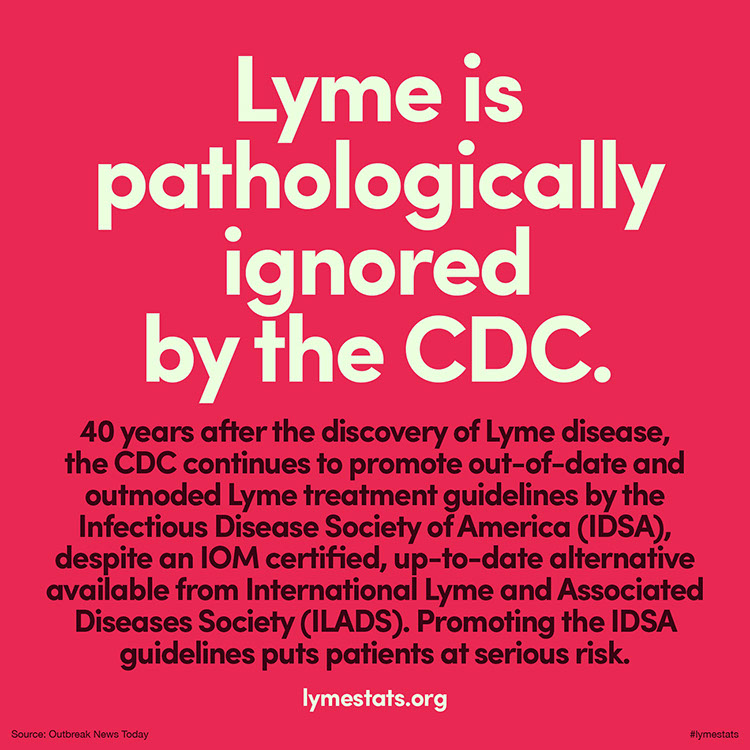
40 years after the discovery of Lyme disease, the CDC continues to promote out-of-date and outmoded Lyme treatment guidelines by the Infectious Disease Society of America (IDSA), despite an IOM certified, up-to-date alternative available from International Lyme and Associated Diseases Society (ILADS). Promoting the IDSA guidelines puts patients at serious risk.
Source: Outbreak News Today

Since the CDC denies the existence of chronic Lyme, insurance companies are not required to cover costs related to the disease. Patients spend on average $53,000 per year out-of-pocket for tests, doctor visits, pharmaceuticals, and supplements. There are currently tens of thousands of online crowdfunding campaigns started by patients to help cover their treatment costs.
Source: Lyme Stats Survey
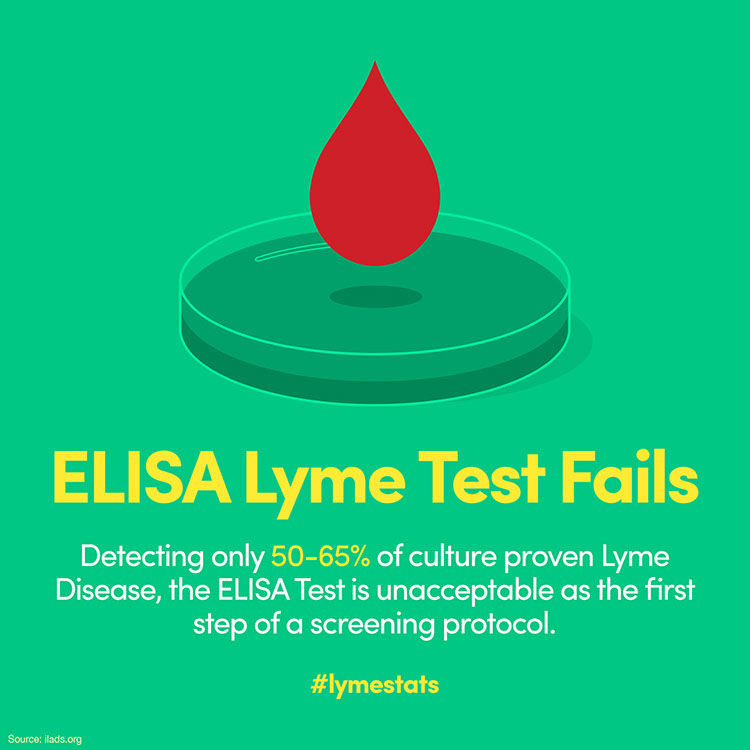
The standard CDC-approved ELISA test picks up only 50-65% of Lyme positive patients and is unacceptable as the first step of a screening protocol.
Source: ILADS
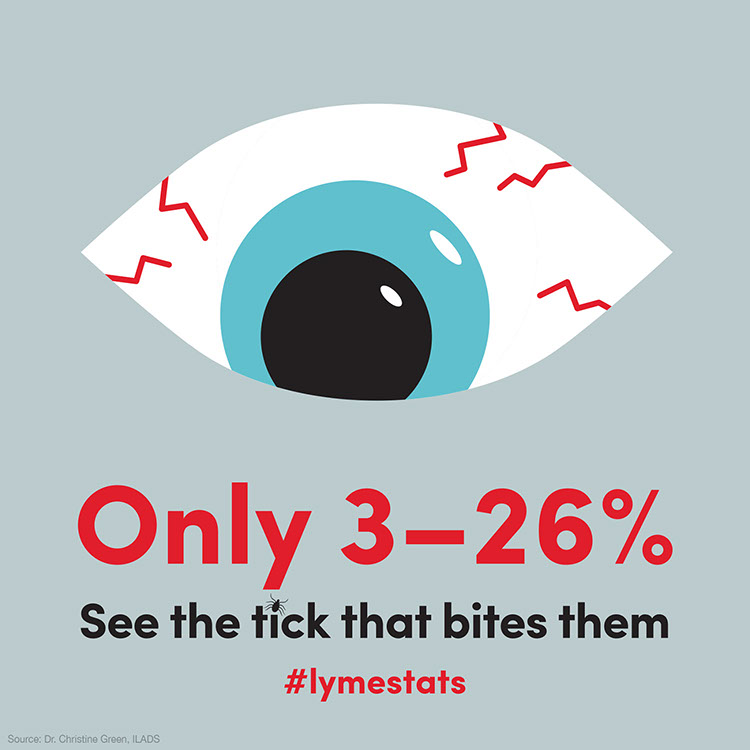
Only 3-26% of people see the tick that bites them.
Source: Dr. Christine Green / ILADS

Does your partner have Lyme? Have safe sex!

Fewer than 50% of Lyme patients recall a rash.
Source: ILADS

Short courses of antibiotics lead to upwards of a 40% relapse rate especially if treatment is delayed. There has never been a study demonstrating that 30 days of antibiotic treatment cures Lyme Disease.
However there is much documentation that short courses of antibiotic treatment fail to eradicate the Lyme spirochete.
Source: ILADS

No test exists that can prove if the Lyme organism is eradicated or that the patient is cured.
Source: ILADS
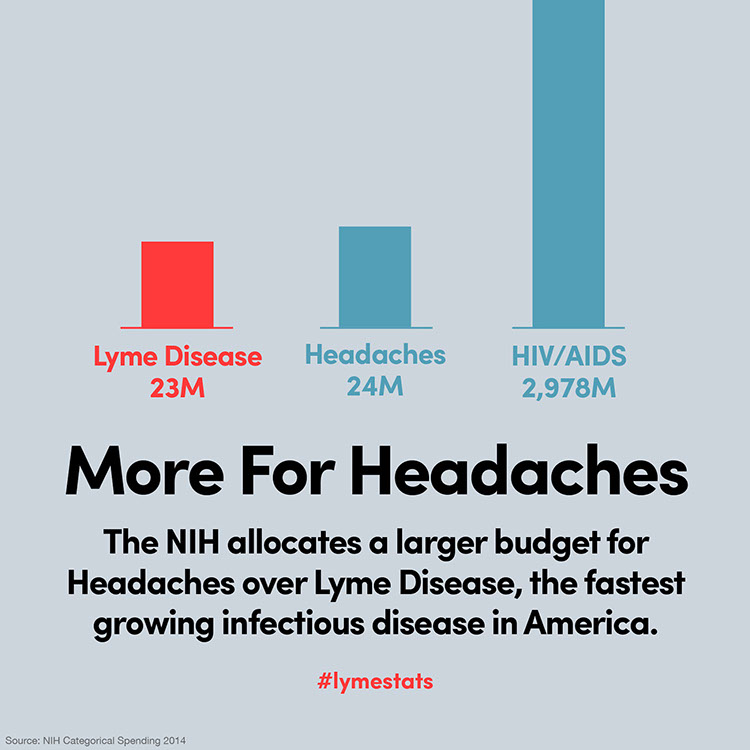
Lyme Disease is the fastest growing infectious disease in America but it is funded less than Headaches.
This excludes funding for research into Chronic Lyme & Co-infections which the CDC claim do not exist, thus are not listed on the NIH budget.
Source: NIH

Estimated total of direct and indirect patient costs vs. total of NIH funding for the CDC's definition of Lyme Disease in 2014. Estimate does not include patients with a misdiagnosis (either of a different disease, syndrome, or simply that they do not have Lyme Disease).
Source: Poughkeepsie Journal, NIH
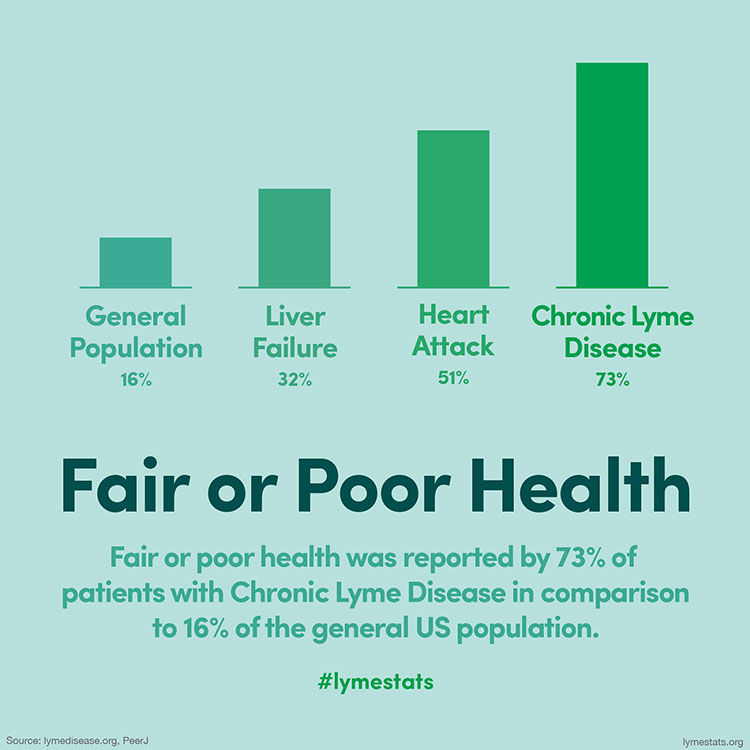
In a 2014 study, 73% of Chronic Lyme patients reported Fair or Poor Health in comparison to 16% of the general public.
Source: PeerJ

There are 5 subspecies of Borrelia Burgdorferi, over 100 strains in the US, and 300 strains worldwide. This diversity is thought to contribute to the antigenic variability of the spirochete and its ability to evade the immune system and antibiotic therapy, leading to chronic infection.
Source: ILADS
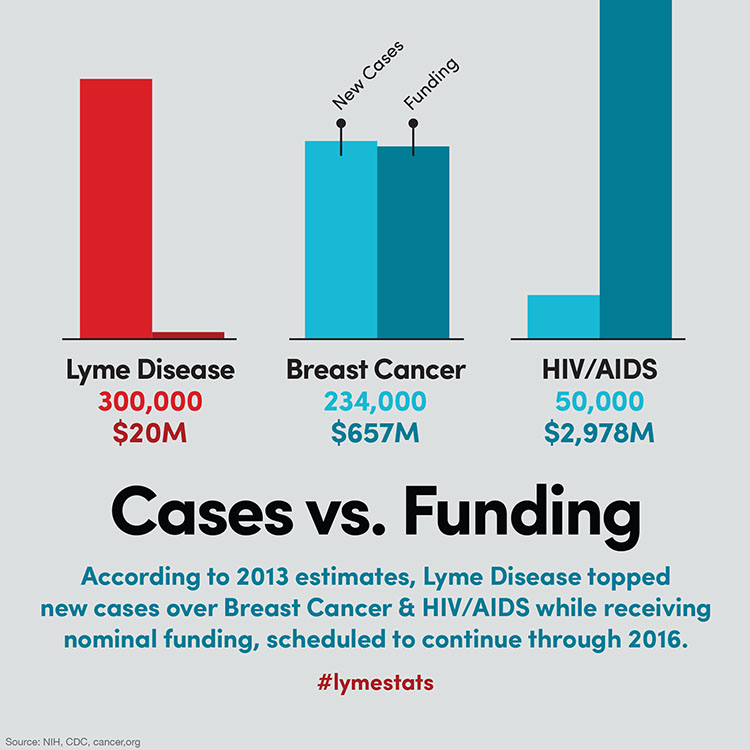
Based on 2013 estimates, Lyme Disease topped new cases over Breast Cancer and HIV/AIDS combined, yet received nominal funding which is scheduled to continue through the 2016 NIH budget.
These estimates do not include data regarding Chronic Lyme Disease & Co-infections.
Source: NIH, CDC, cancer.org
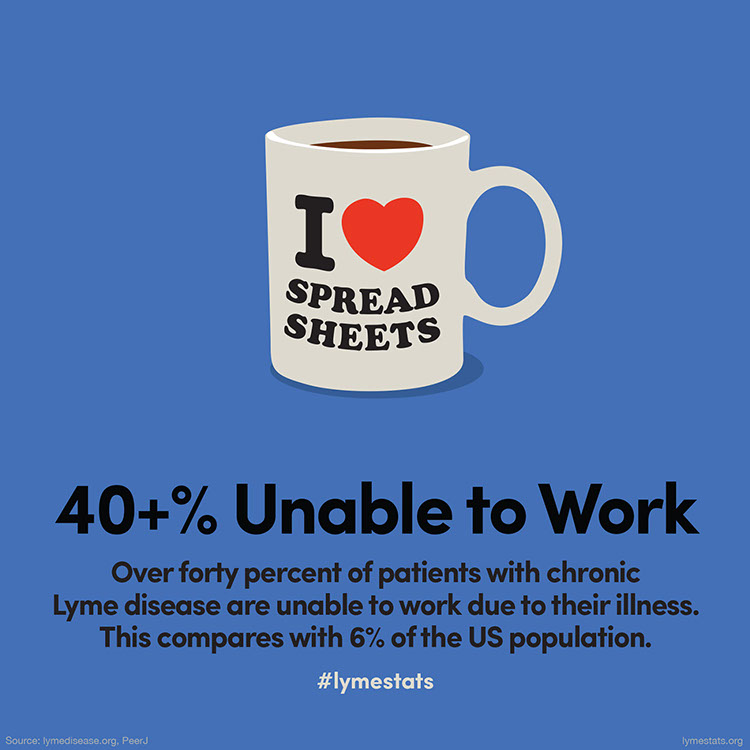
Over 40% percent of patients with chronic Lyme disease reported that they currently are unable to work because of Lyme disease. This compares with 6% of the US population who are unable to work due to illness.
Source: PeerJ

In a 2001 study by Dr. Monica Embers and colleagues, primates were infected with Borrelia bergdorferi (Bb). After four months, they were treated with 28 days of doxycycline per IDSA guidelines. Following treatment, Bb was found in 100% of the primates. This study was held unpublished until 2012.
Source: lymedisease.org

Meant as companion studies, one in humans, one in non-human primates, the Klempner (human) study was rushed to publication in 2001, while the Embers (primates) study remained unpublished until 2012. The IDSA’s recommendation to the CDC on Lyme treatment guidelines rely heavily on the Klempner study and were released in 2006. The Embers study has notably contradictory results from the Klempner study but was not made public until recently.
Source: lymedisease.org
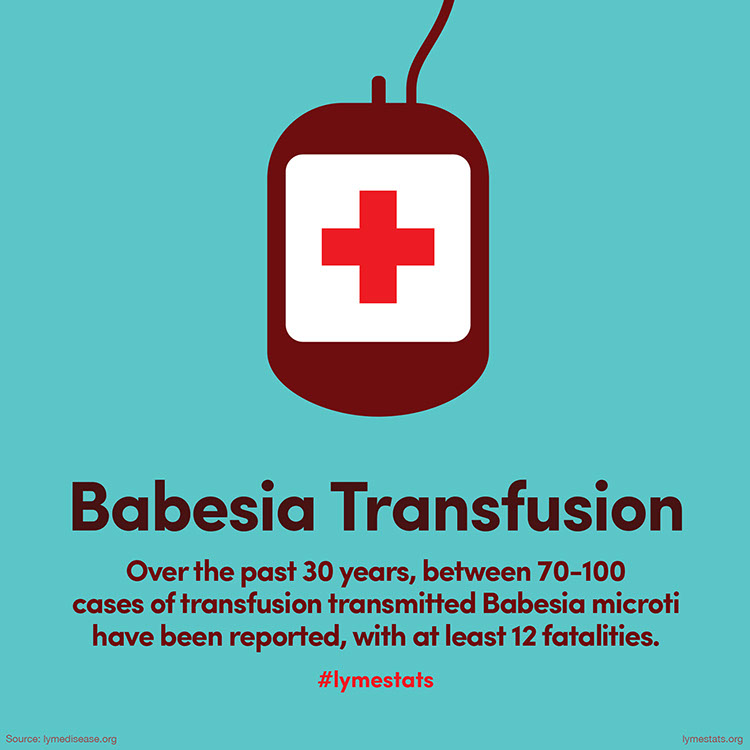
According to the Red Cross' David Leiby, over the past 30 years, between 70-100 cases of transfusion transmitted Babesia microti (a Lyme co-infection) have been reported, with at least 12 fatalities. Better testing is required for more thorough screening of donated blood.
Source: lymedisease.org
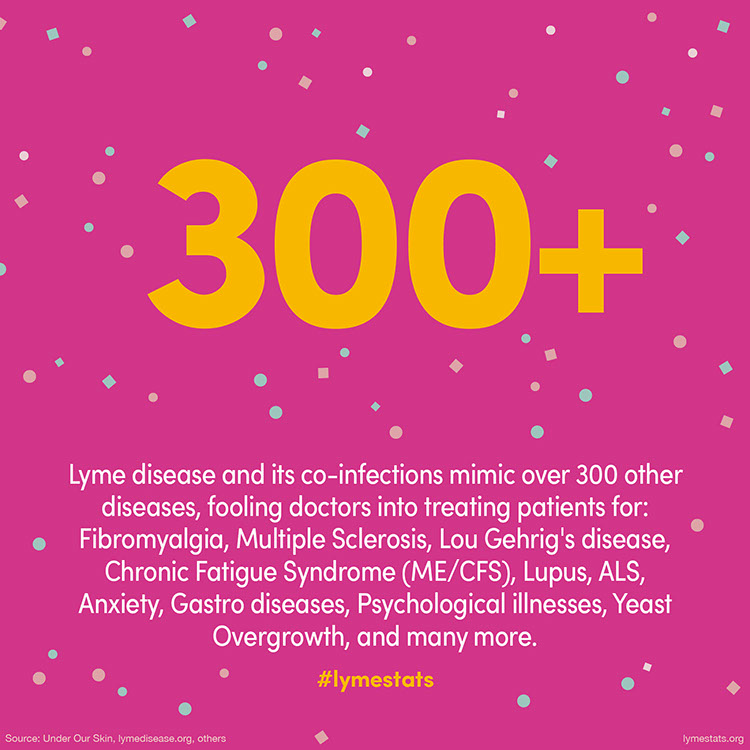
Lyme disease and its co-infections mimic over 300 other diseases including Fibromyaligia, MS, Lou Gehrig’s disease, Chronic Fatique (ME/CFS), Lupus, ALS, Anxiety, Gastro diseases, Psychological illnesses, Yeast Overgrowth, Heart disease, and many more.
Source: Under Our Skin, lymedisease.org, clinical accounts
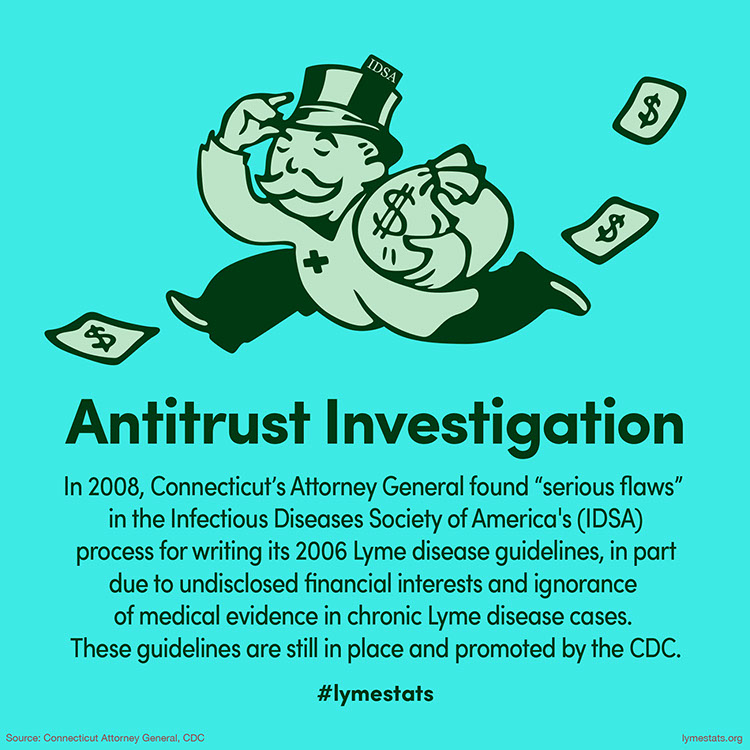
Despite antitrust findings two years after publication, the IDSA 2006 Lyme disease guidelines are still in place and promoted by the CDC, leading to the misdiagnosis of hundreds of thousands of Americans each year.
Source: CT Attorney General, CDC

Do you Herx?
Source: Wikipedia

Do you have biofilms?
Source: NIH
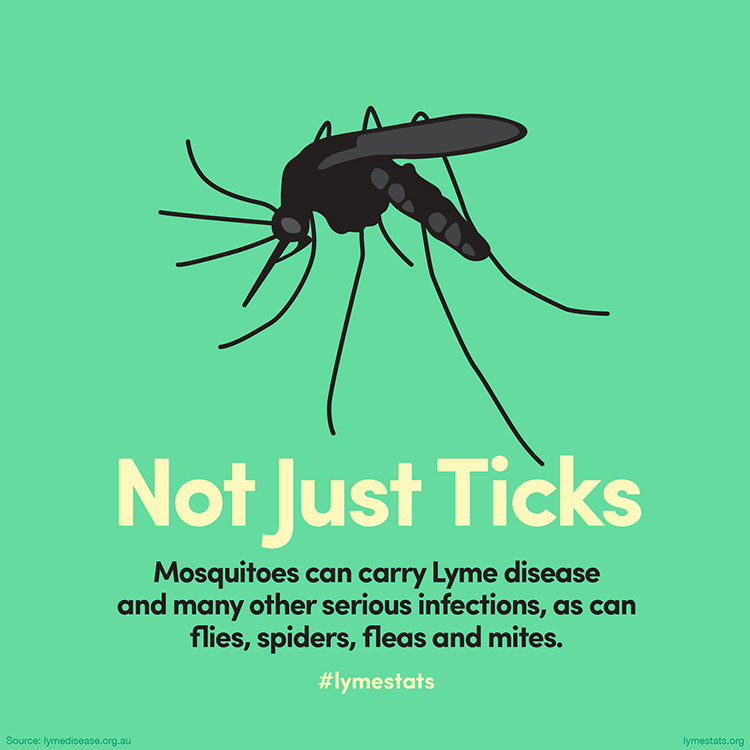
Have you been bitten by a mosquito, large fly, fleas or mites? Check your symptoms.
Source: lymedisease.org.au
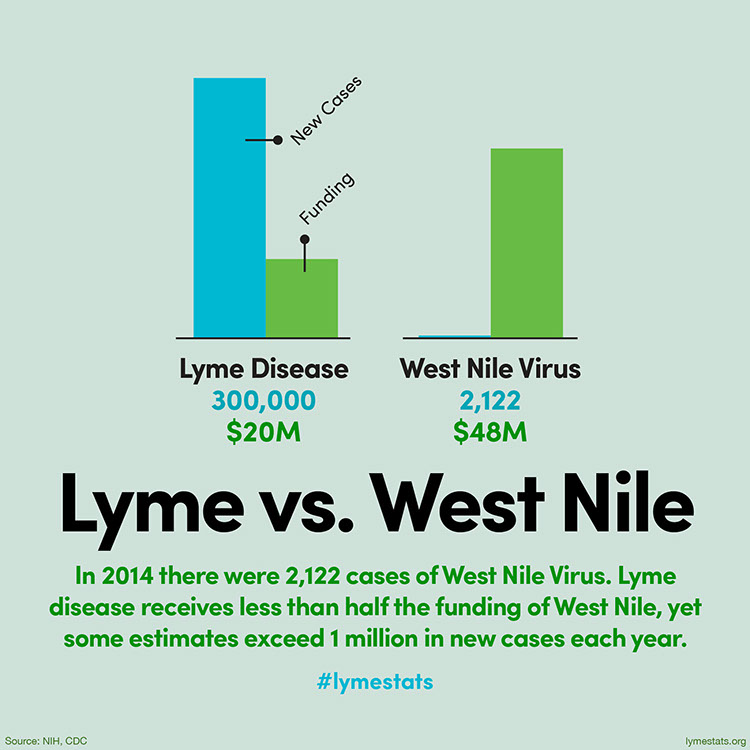
West Nile Virus has a fraction of new cases per year compared to Lyme disease, yet it has more than double the research funding.

Physical or mental health problems limit Lyme patient functioning on 19 days each month compared to only 2 days per month for the general population.
Source: PeerJ
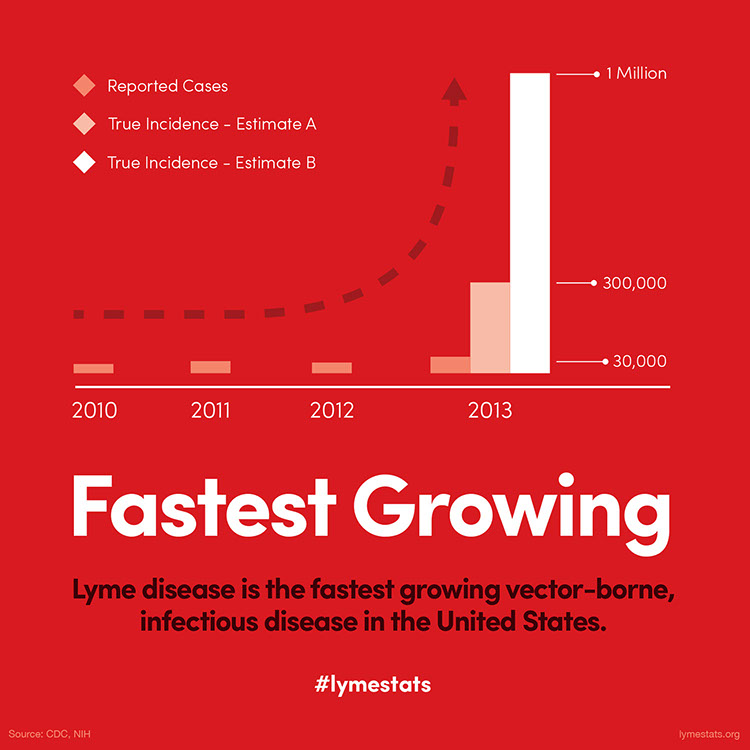
The CDC states that it does not know how many cases of Lyme disease there are in the US. Estimates range from 300,000 to 1 million new cases each year, the majority of which are unreported.

A 1997 study describes elements of the Borrelia bergdorferia genome.
Source: NIH, lymedisease.org
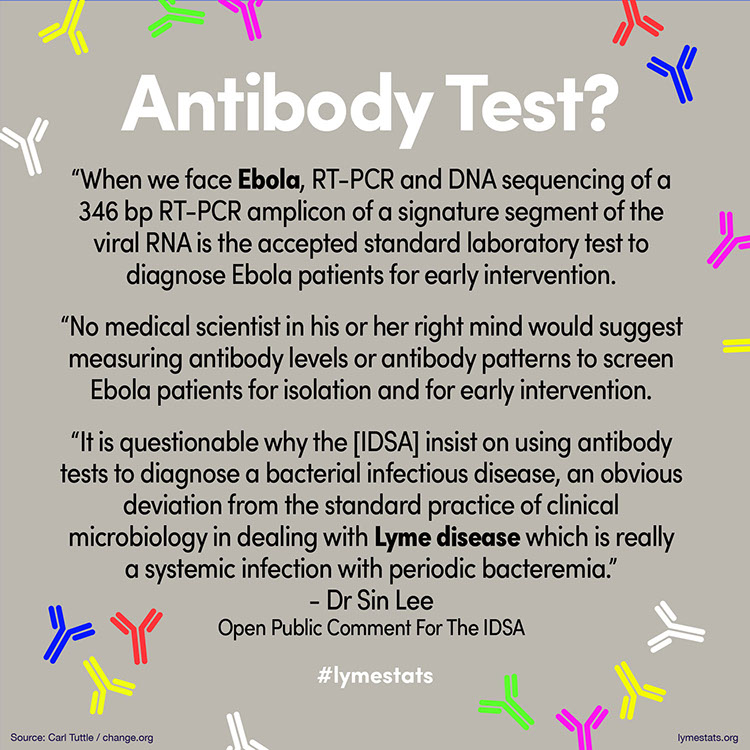
Dr. Sin Lee asks the IDSA: Why an antibody test?
Source: Carl Tuttle

Lyme carditis is an important cause of heart block, the slowing or stopping of a heartbeat. It is generally completely reversible with antibiotic treatment.
Source: NIH

Has your LLMD asked you to stop eating any and all sugars, including agave and honey, and maintain a low-carb diet with low-sugar fruits?
Source: PLOS Pathogens

Do you notice an increase of symptoms during a Full Moon?
Source: Clinically Observed
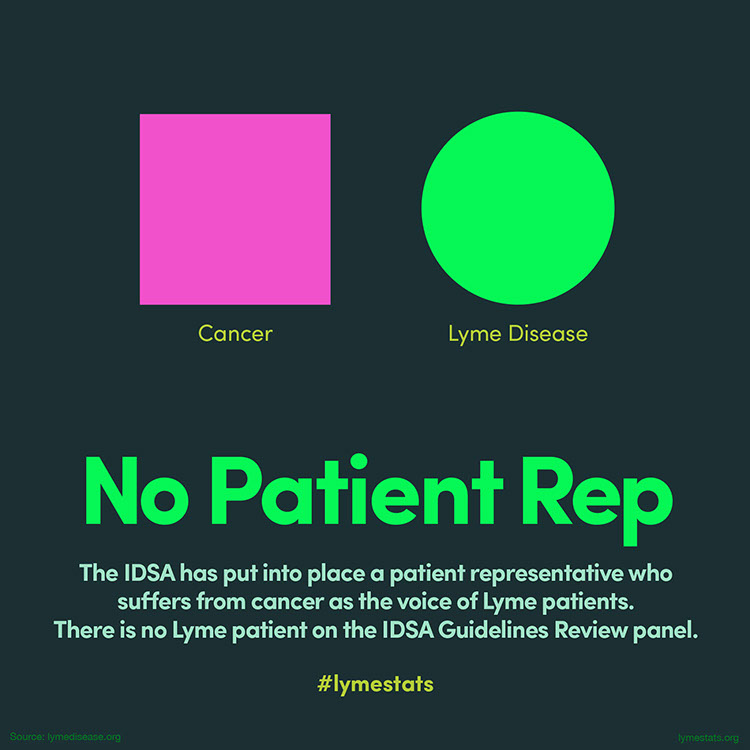
The IDSA still does not have a Lyme patient on its Lyme Guidelines Review panel.
Source: lymedisease.org
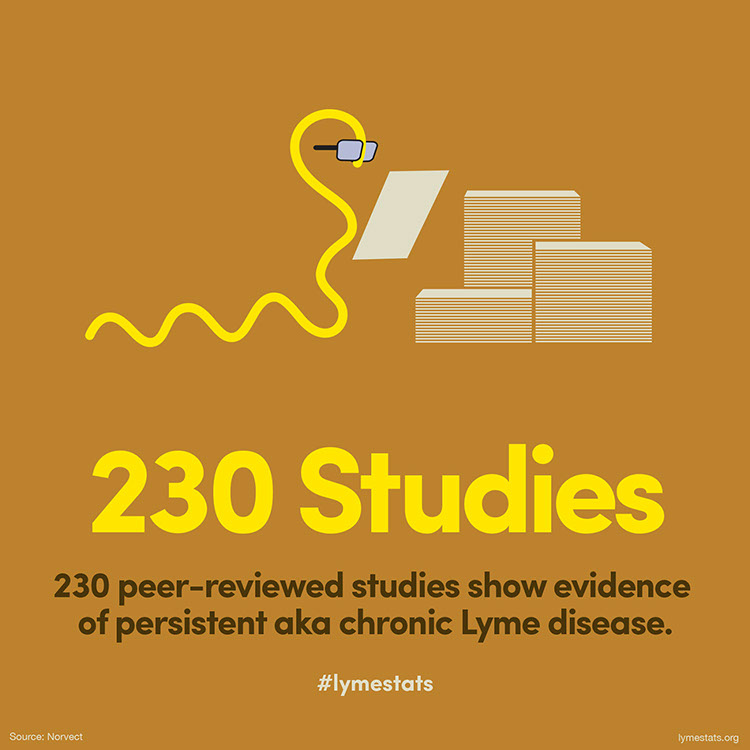
There are 230 peer-reviewed studies that show evidence of persistent Lyme disease, some dating back to the early 1980s.
Source: NorVect

Robert Lane, co-author of a 2015 study of birds in Northern California, says “The fact that we found this particular bacterium for the first time in birds in California is notable because of the ease with which birds can distribute spirochetes to different regions.” Lane is a Medical entomologist and UC Berkeley Professor of the Graduate School.
Source: UC Berkeley, PLOS ONE
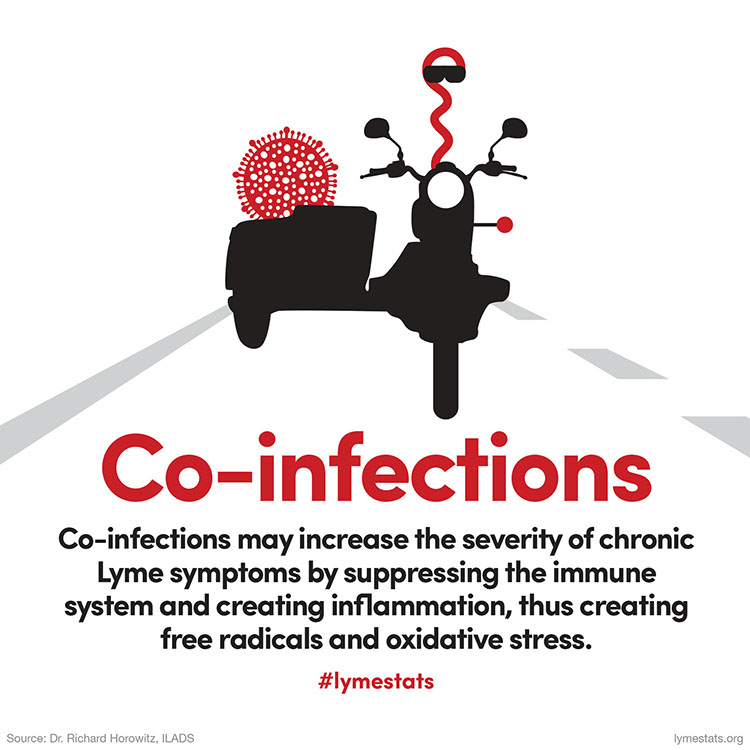
According to Dr. Richard Horowitz, important co-infections and pathogens to address are Erlichiosis/Anaplasmosis, Babesiosis, other parasites, Bartonella, Mycoplasma, Rickettsia, Chlamydia, viruses, and Candida.
Source: Dr. Richard Horowitz, ILADS

Rising cases of Lyme disease are one indicator of Climate Change.
Source: EPA

"The "official" number from our IDSA-guides National Reference Center in Munich is 60,000 - 100,000 each year in Germany. The estimated number in Germany just for bulls-eye rashes was 753,000 in 2008. But we know that not each fresh infected patient in Germany develops a bulls-eye rash, because of several subspecies, especially B. burgdorferi garinii. Therefore, you can double the number of infections, which means 1,500,000 fresh infected Borrelia patients each year in Germany."
Source: Dr. Armin Schwarzbach
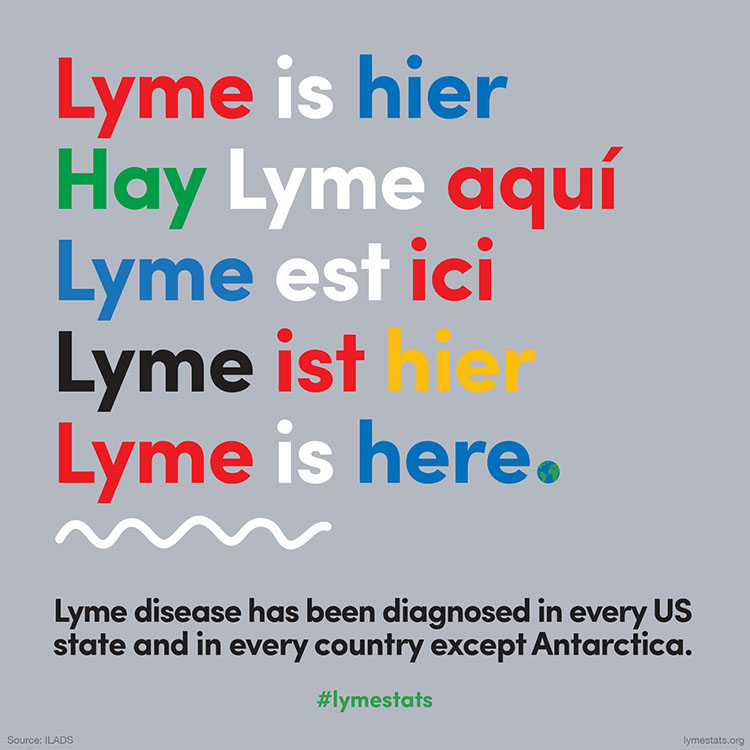
Lyme disease has been diagnosed in every US state and in every country except Antarctica.
Source: ILADS

There has never been a study demonstrating that 30 days of antibiotic treatment cures chronic Lyme disease. However there is much documentation demonstrating that short courses of antibiotic treatment fail to eradicate the Lyme spirochete.
Source: ILADS
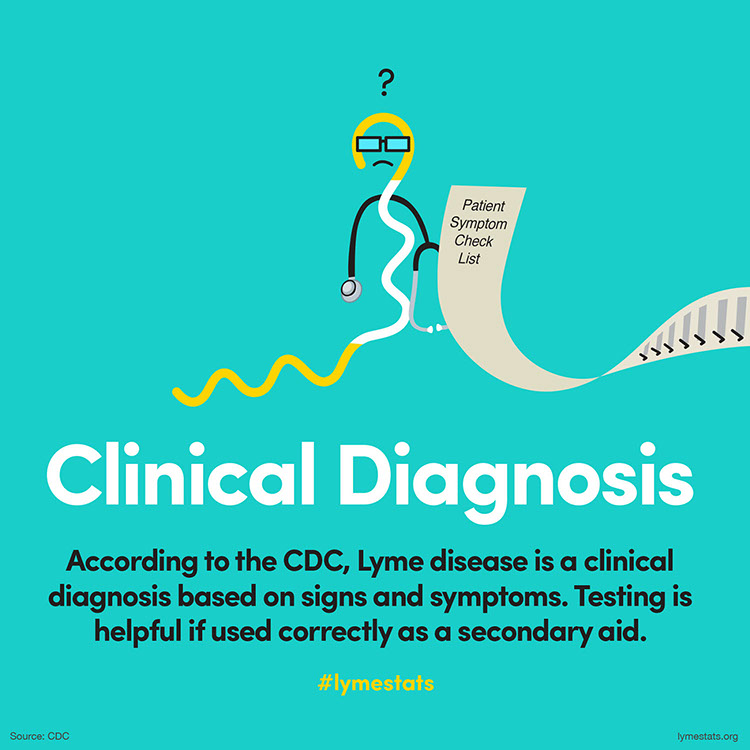
Lyme disease is a clinical diagnosis.
Source: CDC
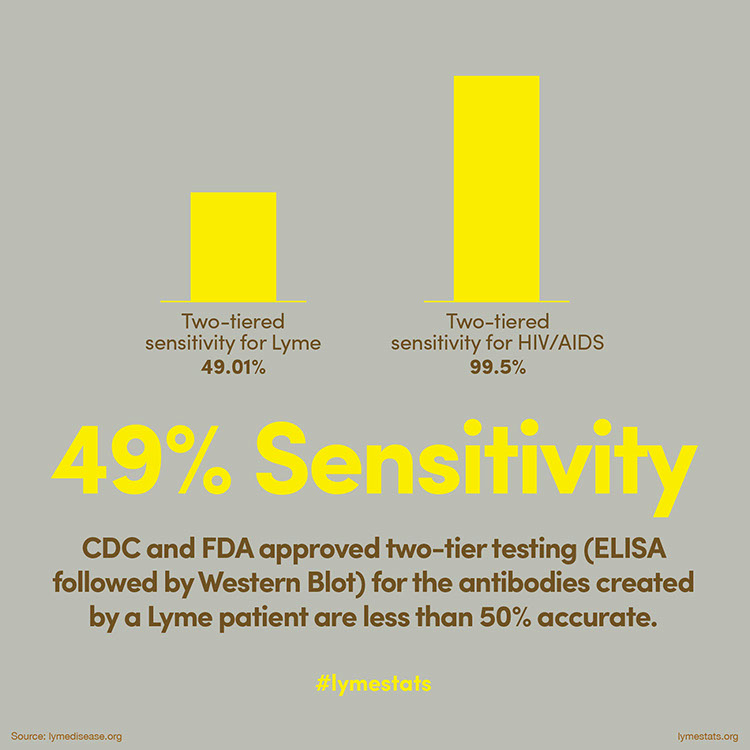
Two-tiered testing is the standard Lyme test set forth by the CDC. It is what a non-Lyme literate doctor will give you in their office.
Source: lymedisease.org
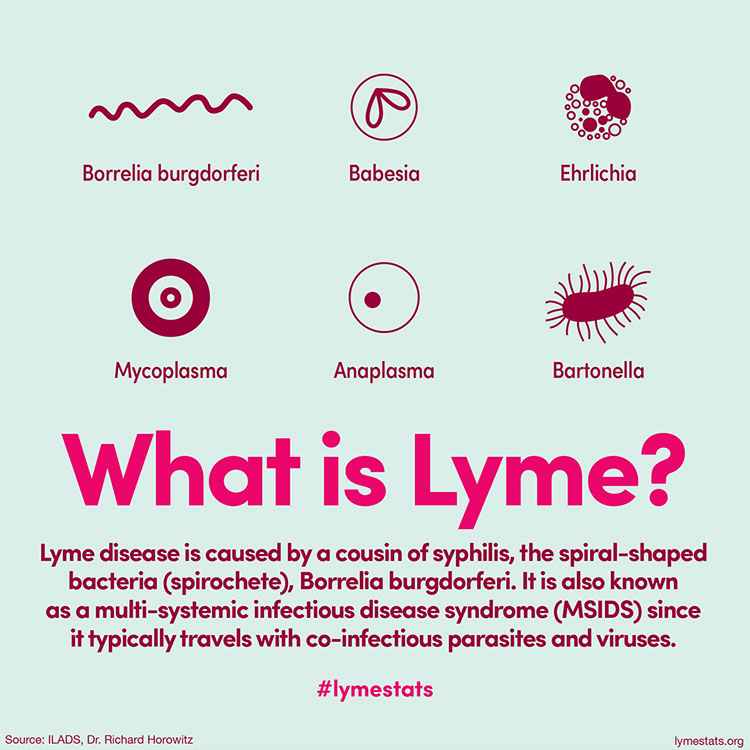
Lyme is caused by the spiral-shaped bacteria, Borrelia. It is often transmitted along with other co-infectious parasites and viruses.
Source: ILADS, Dr. Richard Horowitz
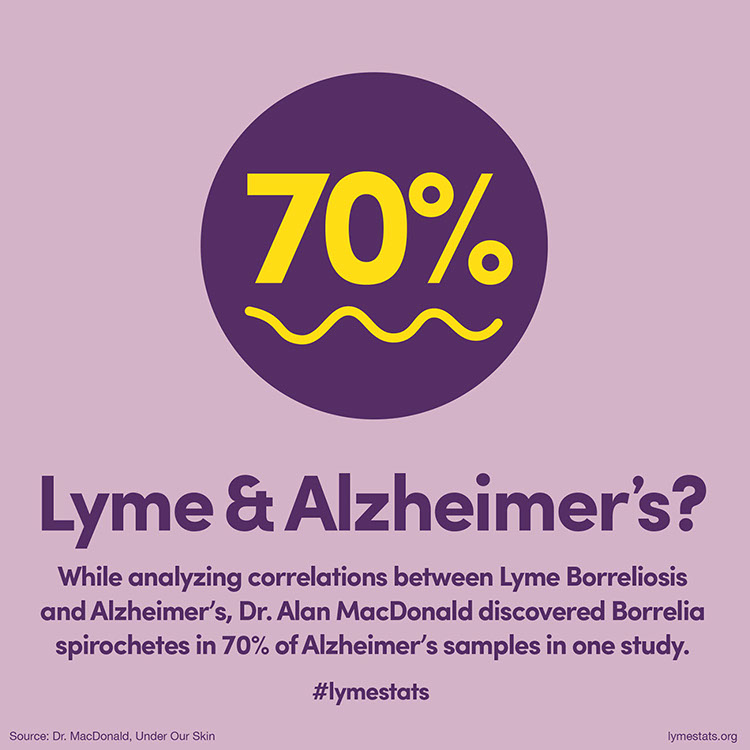
Dr. Alan MacDonald has performed extensive independent research into the correlation between Lyme Borreliosis and Alzheimer's disease. In one study, he found Borrelia in 7 out of 10 of the brain tissue samples.
Source: Dr. Alan MacDonald, Under Our Skin

Pennsylvania ranks No. 1 in cumulative reported cases between 2009-2013. In a new study, ticks collected throughout the state were positive for Borrelia burgdorferi, Babesia microti, and Anaplasma phagocytophilum.
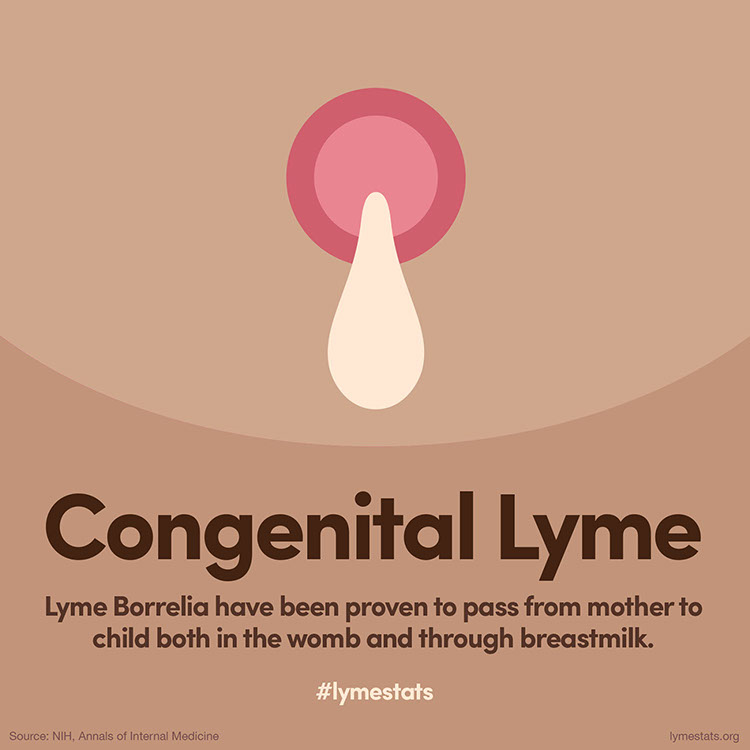
Lyme Borrelia have been proven to pass from mother to child both in the womb and through breastmilk.
Source: NIH, Annals of Internal Medicine
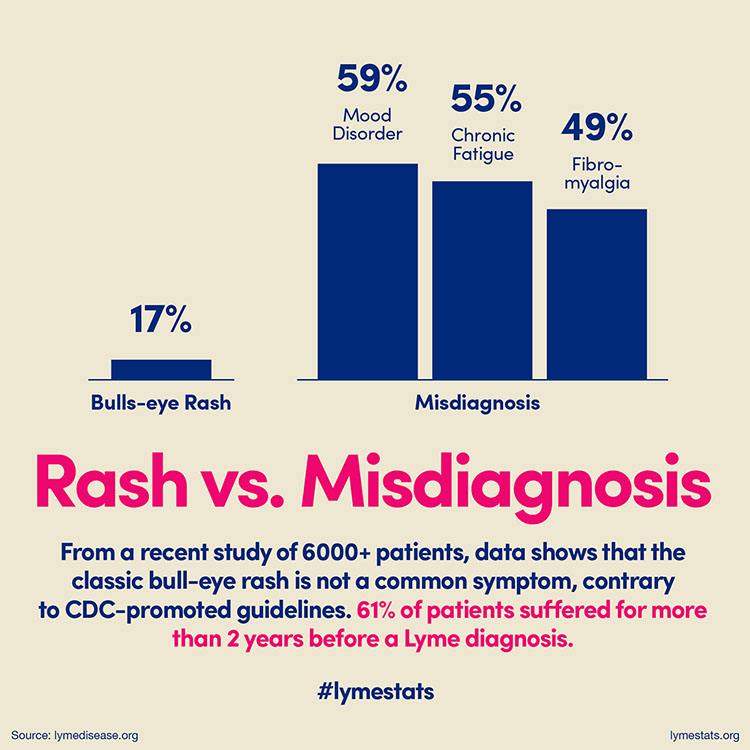
Only 17% of those responding in a new survey of over 6,000 patients had the classic bulls-eye rash. The CDC claims that this is the most common symptom. Instead, over half were misdiagnosed and had to suffer through symptoms for more than two years before receiving a correct Lyme diagnosis.
Source: lymedisease.org

In a recent study of over 6,000 patients, half were sick with Lyme for more than 10 years. Over 90% of survey respondents reported failing short term treatment protocols. The CDC claims that chronic Lyme does not exist and can be eradicated with an early short course of antibiotics.
Source: lymedisease.org
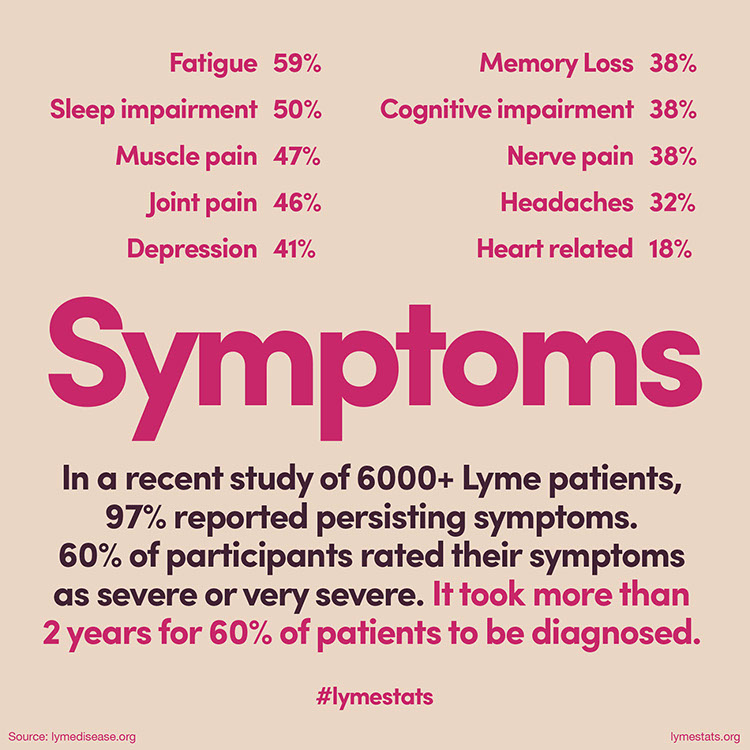
In a recent study of 6000+ Lyme patients, 97% reported persisting symptoms. 60% of participants rated their symptoms as severe or very severe. It took more than 2 years for 60% of patients to be diagnosed.
Source: lymedisease.org
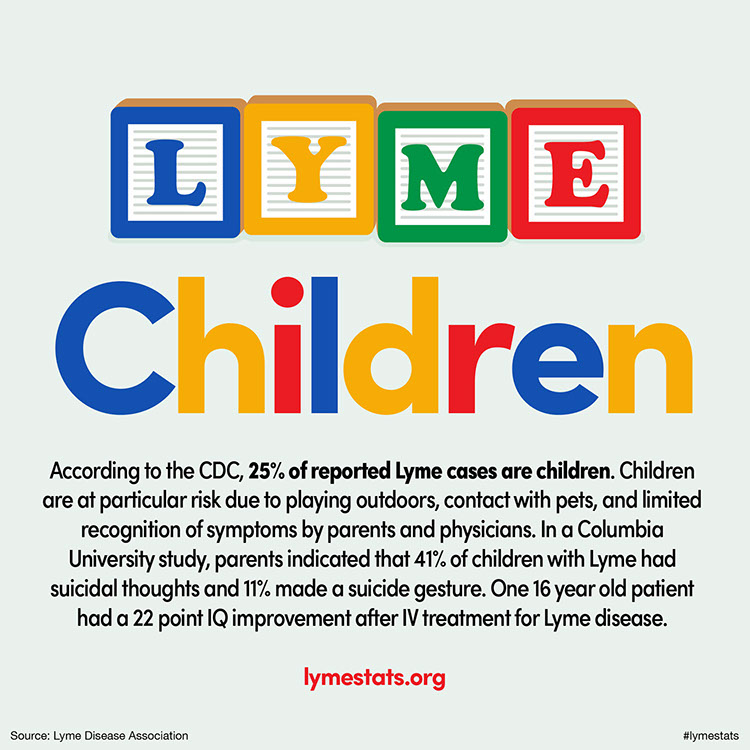
Children are at particular risk of Lyme disease and its overwhelming symptoms.
Source: Lyme Disease Association
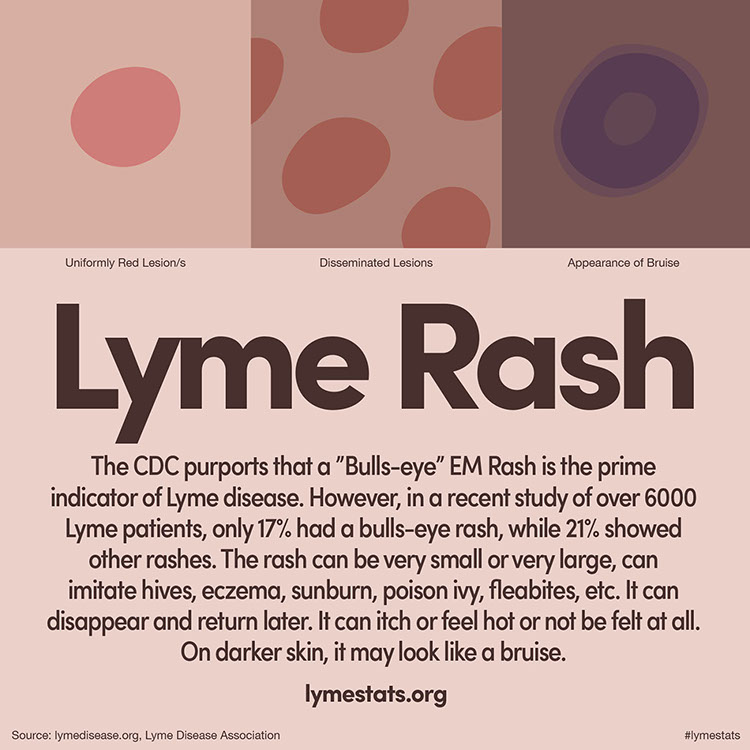
The "classic" Bulls-eye EM Rash is NOT the most common signifier of Lyme disease.
Source: lymedisease.org, Lyme Disease Association
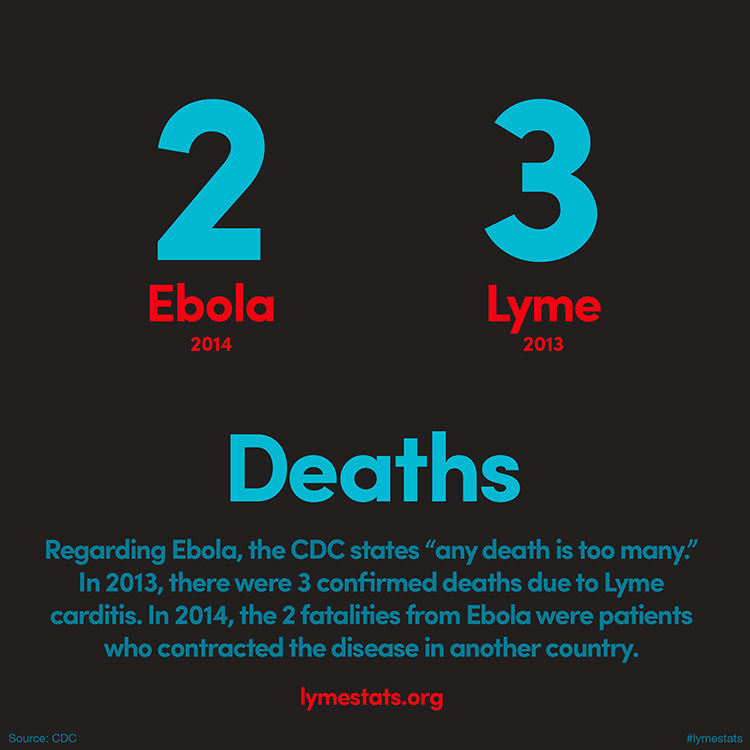
The CDC states that with regard to Ebola, "any death is too many." In 2014, two patients who contracted Ebola overseas died. In 2013, Lyme carditis was the confirmed cause of three fatalities. Due to the reporting requirements of Lyme disease to the CDC, the true incidence of Lyme-related fatalities are not known. Since 2013, funding for Lyme disease research has not increased.
Source: CDC

In late 2014, Congress agreed to spend $5.4 billion on Ebola treatment and prevention measures in the U.S. and West Africa. This compares to $23 million in funding
for Lyme, America’s fastest growing infectious disease.
Source: NIH

Lyme disease patients are twice as likely to be seen in emergency rooms as the general population.
Source: lymedisease.org, PeerJ
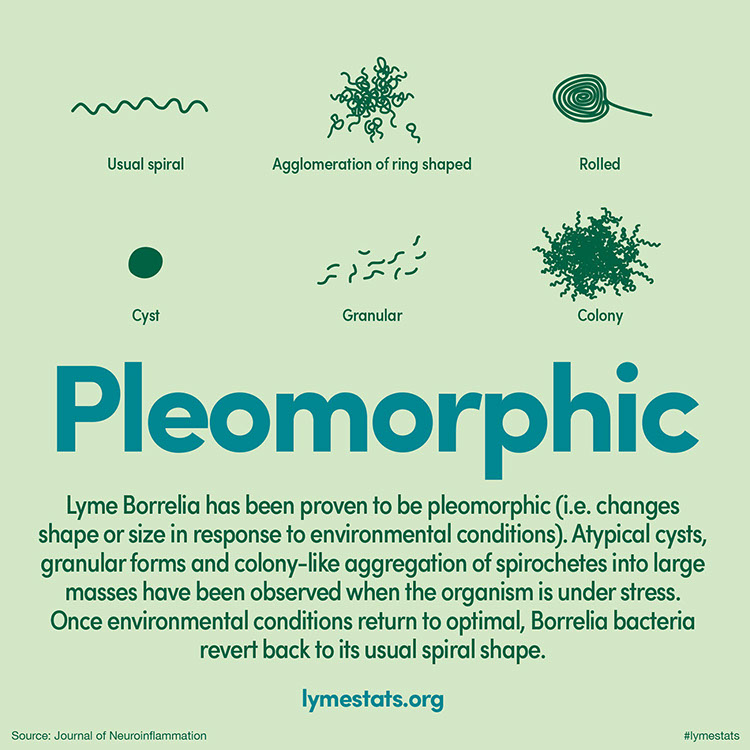
"The persistence of these more resistant spirochete forms, and their intracellular location in neurons and glial cells, may explain the long latent stage and persistence of Borrelia infection. The results also suggest that Borrelia burgdorferi may induce cellular dysfunction and apoptosis. The detection and recognition of atypical, cystic and granular forms in infected tissues is essential for the diagnosis and the treatment as they can occur in the absence of the typical spiral Borrelia form."
Source: Journal of Neuroinflammation

Borrelia bacteria show three main forms: spiral-shaped Spirochete, rolled-up Cyst form, and cell wall deficient L-form. When under stress, the spirochete will change to either cyst or L-form to avoid immune system or antibiotic attack. When conditions are again favorable, the bacteria revert to spiral shape.
Source: Dr. Alan MacDonald
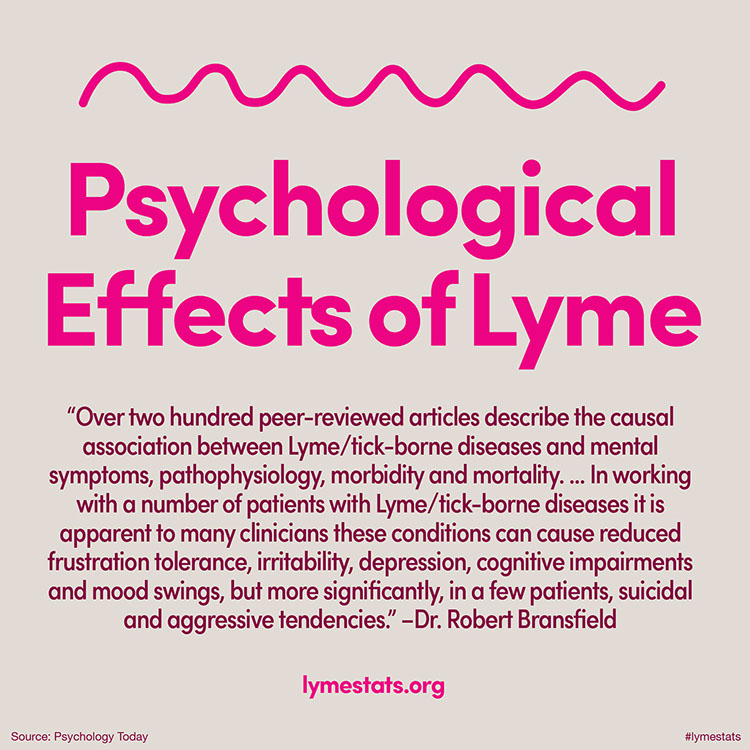
Lyme and other tick-borne diseases are proven to have influence over a patient's mental state.
Source: Psychology Today

According to Dr. Richard Horowitz, China's CDC privately disclosed that 6% of their population has Lyme disease. That is 83,627,030 people.
Source: Dr. Richard Horowitz
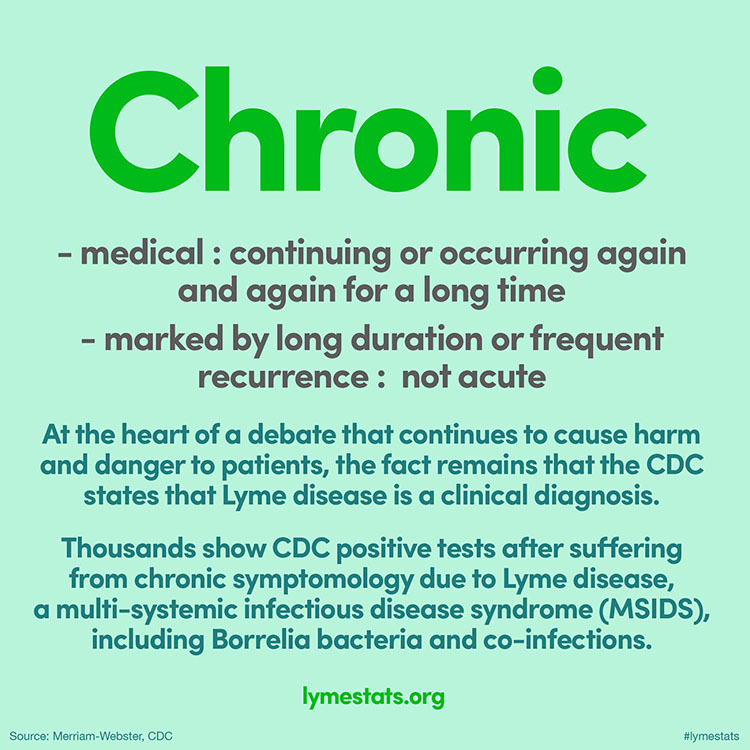
At the center of the Lyme disease debate is the CDC qualification of Lyme as a clinically diagnosed disease. Based on this criteria, prolonged symptomology alone determine Lyme to be capable of a chronic state. Alternately, thousands suffer prolonged Lyme symptoms for several years and then are confirmed CDC positive in testing, again following the definition of chronic disease.
Source: Merriam-Webster, CDC
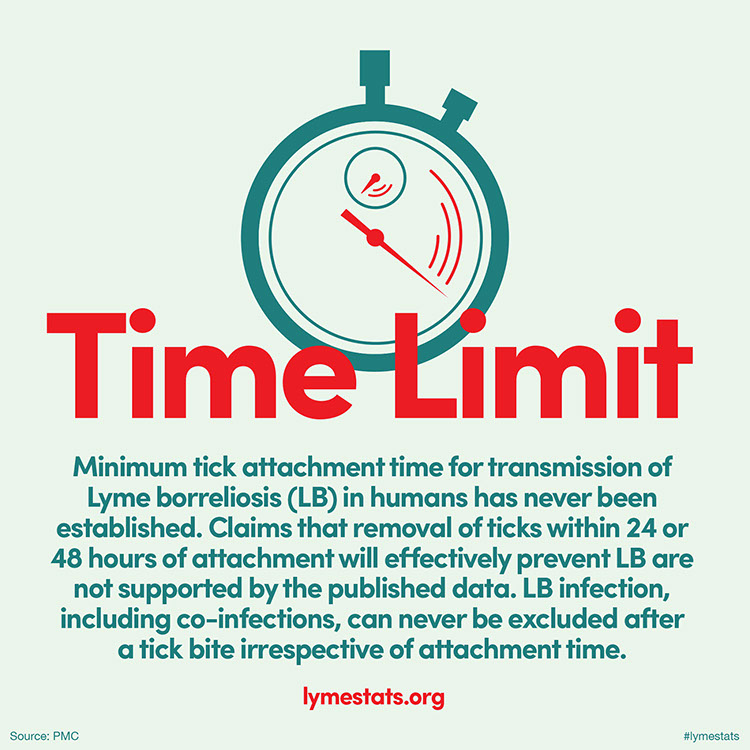
The claims that removal of ticks within 24 hours or 48 hours of attachment will effectively prevent Lyme borreliosis (LB) are not supported by the published data, and the minimum tick attachment time for transmission of LB in humans has never been established. LB infection, including co-infections, can never be excluded after a tick bite irrespective of the estimated duration of attachment time.
Source: PMC

A tick attaches itself very firmly to a host through its use of chelicerae, long rods that end in hooked teeth. Through this mechanism, the tick is ensured to keep its feeding tube connected for a lengthy period of time. Through this tube, blood flows in while parasites, bacteria, and viruses flow out into the host. More on this in a second post.
Source: National Geographic
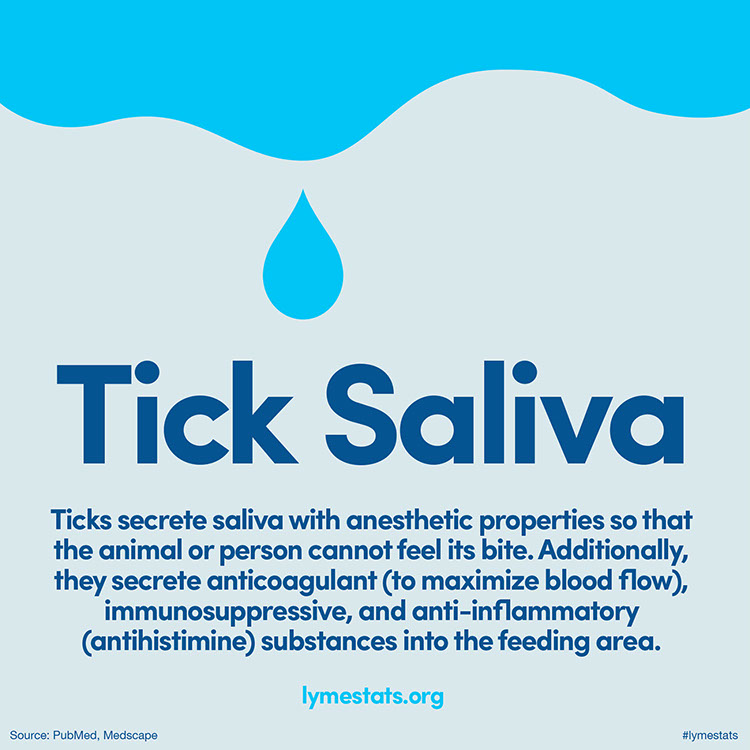
Ticks are excellent transmitters of disease. Their saliva contains an anesthetic (so you do not feel the bite), antihistimine (so the bite does not itch), and anticoagulant (to maximize steady blood flow). Prevent a bite by spraying clothes with permethrin (good for up to six washes) and spray body with 20-30% DEET before going outside. After coming in from outdoors, throw your clothes into the dryer for 15-20 minutes on high to kill any ticks along for the ride and do a thorough tick check. They can be the size of a poppy seed and like to hide in warm protected places.

You can get Lyme disease in New York City.
Source: Dr. Leo Galland

Lyme disease is in San Francisco. Multiple strains have been detected throughout the Bay Area.
Source: Stanford, UC Berkeley
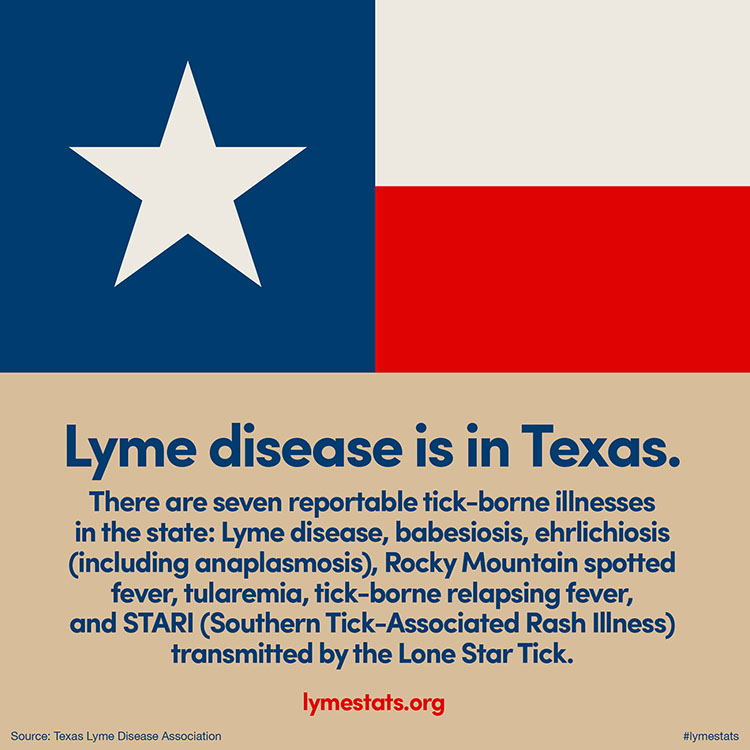
There are seven reportable tick-borne illnesses in the state: Lyme disease, babesiosis, ehrlichiosis (including anaplasmosis), Rocky Mountain spotted fever, tularemia, tick-borne relapsing fever, and STARI (Southern Tick-Associated Rash Illness) transmitted by the Lone Star Tick.
Source: Texas Lyme Disease Association

Dogs can suffer from Lyme disease. They can also bring ticks into your home.
Source: PetMD

Bartonella is a facultative intracellular parasite and opportunistic pathogen. It can be transmitted by ticks, fleas, sand flies, and mosquitoes. There are at least 8 species or subspecies. Bartonella henselae (also transmitted by cats and responsible for “cat scratch fever”) is generally resistant to penicillin, amoxicillin, and nafcillin. Bartonella is known to be a possible co-infection of Lyme Borrelia.
Source: Wikipedia
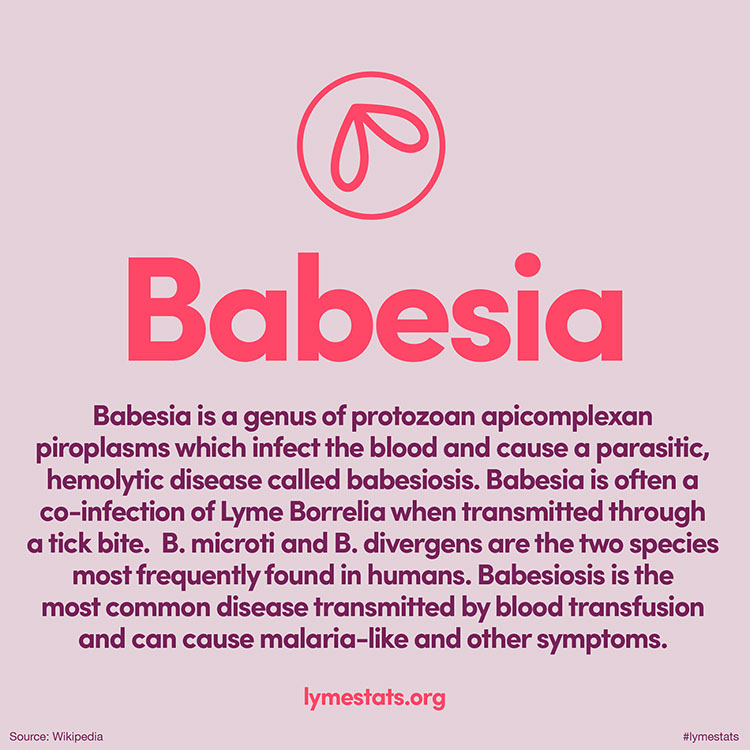
Babesia is a genus of protozoan apicomplexan piroplasms which infect the blood and cause a parasitic, hemolytic disease called babesiosis. Babesia is often a co-infection of Lyme Borrelia when transmitted through a tick bite. B. microti and B. divergens are the two species most frequently found in humans. Babesiosis is the most common disease transmitted by blood transfusion and can cause malaria-like and other symptoms.
Source: Wikipedia

From 1999 to 2001, Dr. Martin Atkinson-Barr tested 150 ALS patients for Lyme disease. “Not one patient was found to be negative across all tests. Many were PCR positive. Effective treatment of late stage ALS is possible with aggressive antibiotic therapy that must include metronidazole. Other researchers have recently reported success in treating early stage ALS with antibiotic therapy.”
–Dr. Martin Atkinson-Barr
Source: Dr. Martin Atkinson-Barr

University of Richmond is tracking tick and Lyme case expansion as tick populations grow and spread across the state of Virginia.
Source: The Roanoke Times
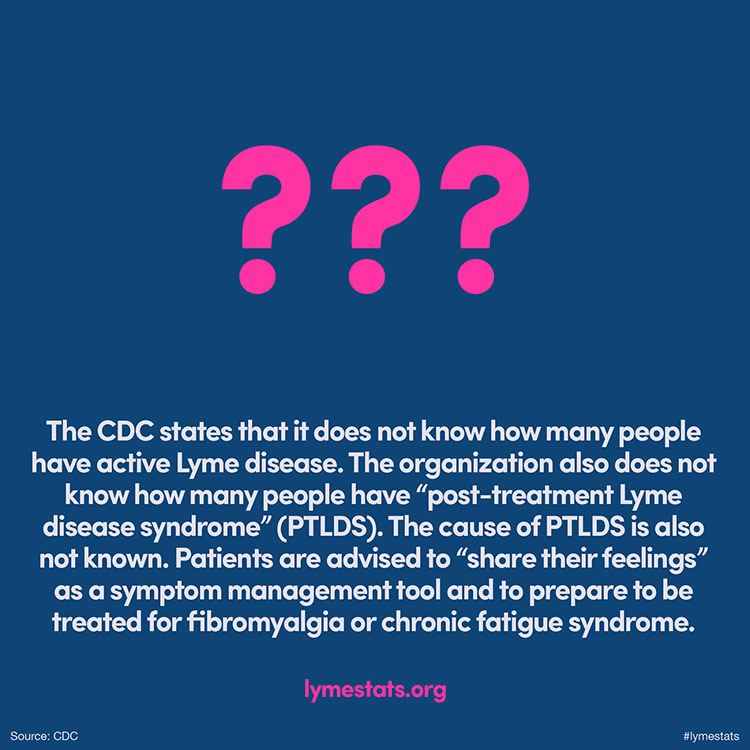
NIH funding for Lyme disease in 2014, 2015, 2016 is $23M per year. This funding is dedicated to studying the acute stages of Lyme and potential vaccines. Among this figure for 2014, the only funding partially dedicated to post-infectious syndrome is $435,000 for "Autoimmunity to ECGF in Lyme disease and its post-infectious syndromes" granted to Dr. Allen Steere.
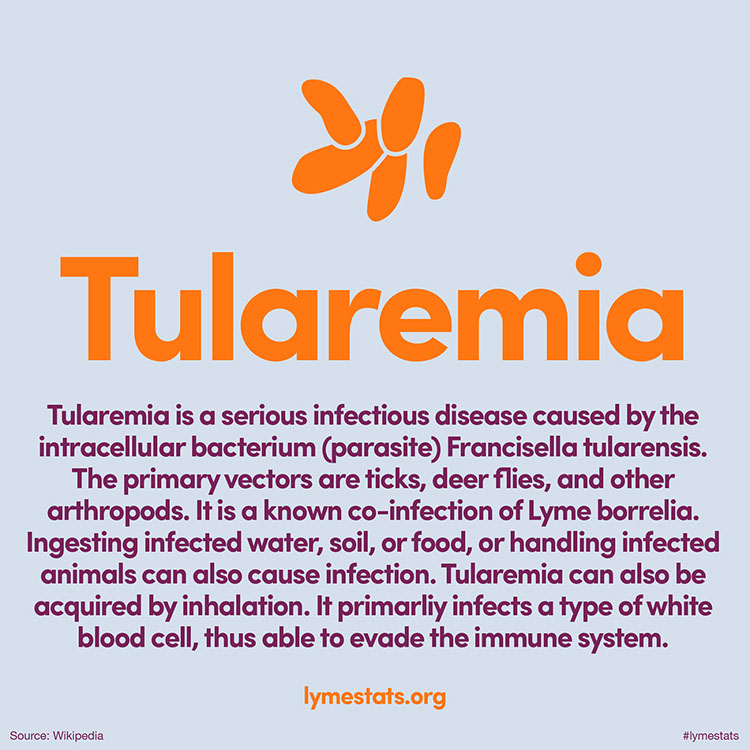
Tularemia is a known co-infection of Lyme borrelia via tick bite transmission. It can evade a host's immune system by infecting a type of white blood cell. Over the course of infection the organism spreads to multiple organ systems. Transmission is also possible through handling infected animals, inhalation, or ingesting infected water, soil, or food.
Source: Wikipedia

Military personnel are at risk of contracting Lyme and other vector-borne diseases while on duty around the world. Lyme disease cases in US vets have been confirmed from 120 locations worldwide. The US Department of Defense just appropriated $5M of their upcoming budget to Lyme disease research.
Source: US Representative Chris Smith
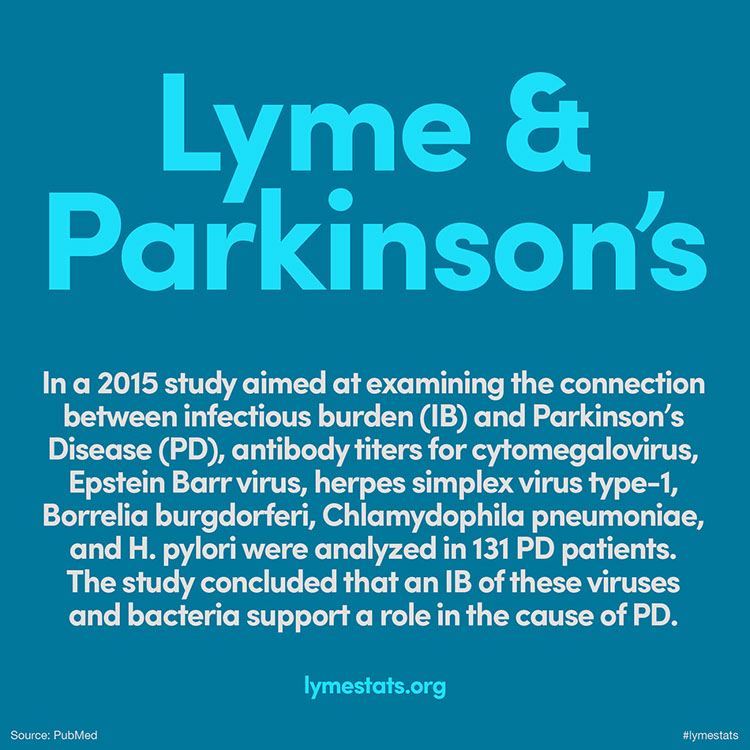
In the United States, 50,000-60,000 new cases of Parkinson's Disease (PD) are diagnosed each year, adding to the one million people who currently have PD. In a 2015 study, an infectious burden from a collection of pathogens including EBV and Borrelia burgdorferi were analyzed in 131 PD patients. The study supports the role of infection in the etiology (cause) of PD.
Source: PubMed

This 2015 study confirms Borrelia burgdorferi, the causative agent of Lyme disease, forms drug-tolerant persister cells, thusly confirming the existence of chronic Lyme disease.
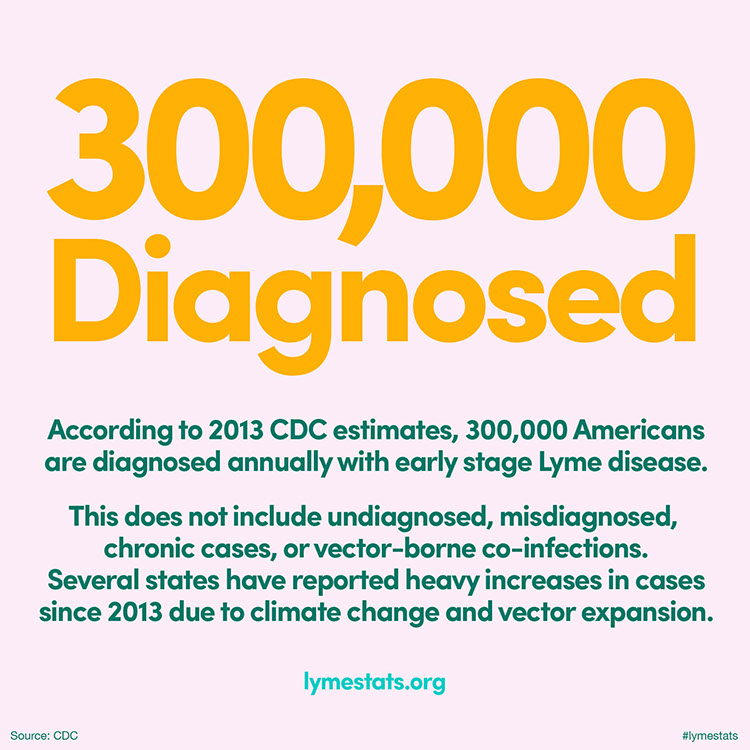
According to the CDC's rough estimate of 300,000 new cases per year, by the end of this year, close to 1 million new cases would have been diagnosed in the US since the initial estimate. However, several states have reported surges in Lyme cases in the last two years due to climate change and vector expansion. The CDC figure does not include undiagnosed, misdiagnosed, chronic cases, nor does it include vector-borne co-infections.
Source: CDC
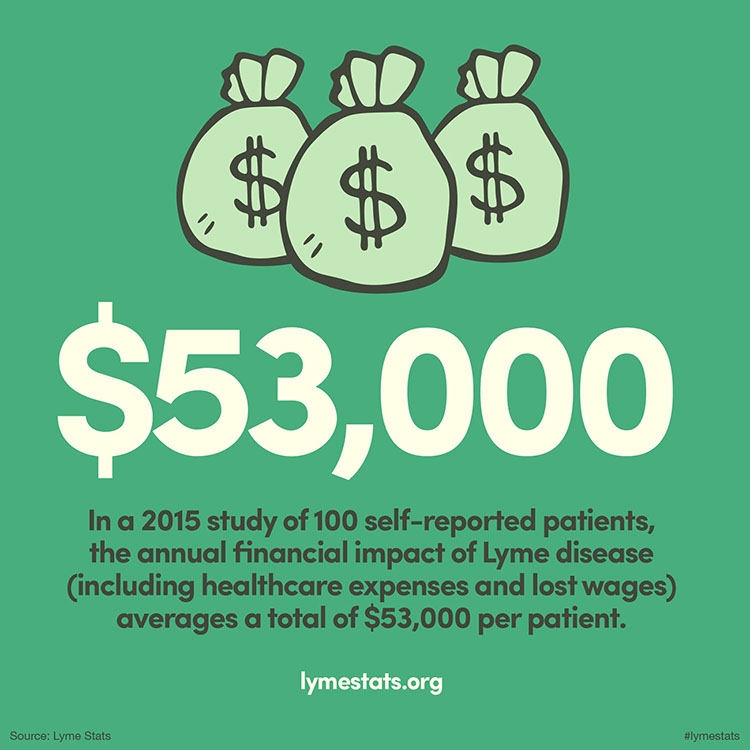
In a 2015 study of 100 self-reported Lyme patients, the financial impact of Lyme disease per patient averaged $53,000. This included all healthcare expenses including out of pocket, insurance costs, and lost wages.
Source: Lyme Stats

Currently the IDSA does not follow federal standards with regard to rewriting the Lyme treatment guidelines.
Source: Poughkeepsie Journal

According to recent vector expansion models, by 2020, 80% of the Canadian population (over 28 million) will be exposed to the deer tick, a main vector transmitting Lyme Borrelia.
Source: The Nature of Things, CBC
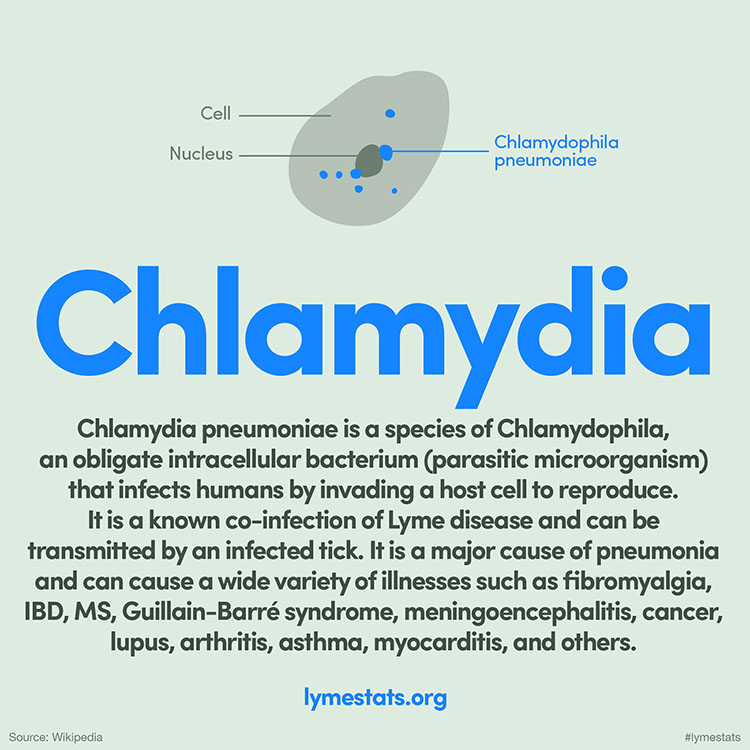
Chlamydia pneumonia is an intracellular parasite. This microorganism is a known co-infection to Lyme disease and can be transmitted by a tick. It is a major cause of pneumonia and can cause a wide variety of illnesses such as fibromyalgia, IBD, MS, Guillain-Barré syndrome, meningoencephalitis, cancer, lupus, arthritis, asthma, myocarditis, and others. There have been studies linking Chlamydia pneumonia to Alzheimer's.
Source: Wikipedia
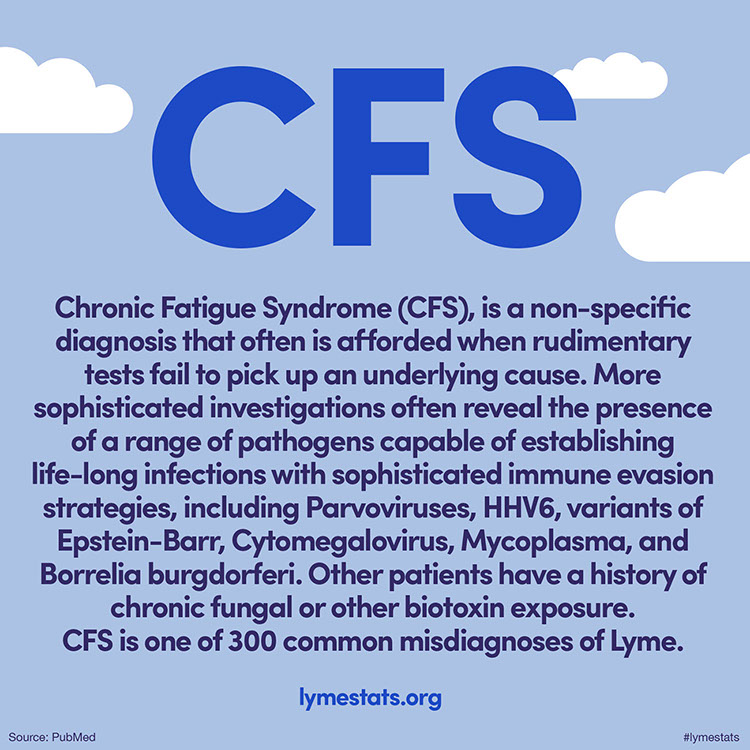
One of the most common misdiagnoses of Lyme disease, Chronic Fatigue Syndrome (CFS) is a non-specific diagnosis given when rudimentary tests fail to uncover the underlying cause. More sophisticated investigations often reveal the presence of a range of pathogens capable of establishing life-long infections with sophisticated immune evasion strategies. Among these pathogens are Borrelia burgdorferi and common Lyme disease co-infections such as HHV6, EBV, Mycoplasma.
Source: PubMed

Borrelia burgdorferi initially trigger a strong immune response in infected animals which lasts for only a short while. The Lyme-causing bacteria quickly cause structural abnormalities in lymph nodes and lymph tissue which prevent immunity from future infections of Borrelia and others such as influenza.
Source: PLOS
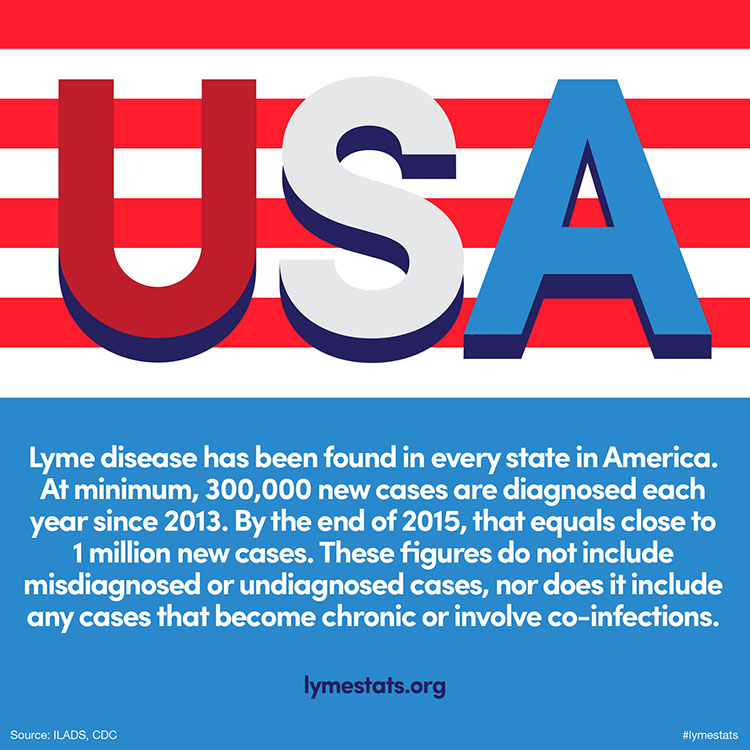
Lyme disease has been found in every state in America. At minimum, 300,000 new cases are diagnosed each year since 2013. By the end
of 2015, that equals close to 1 million new cases. These figures do not include misdiagnosed or undiagnosed cases, nor does it include any cases that become chronic or involve co-infections.
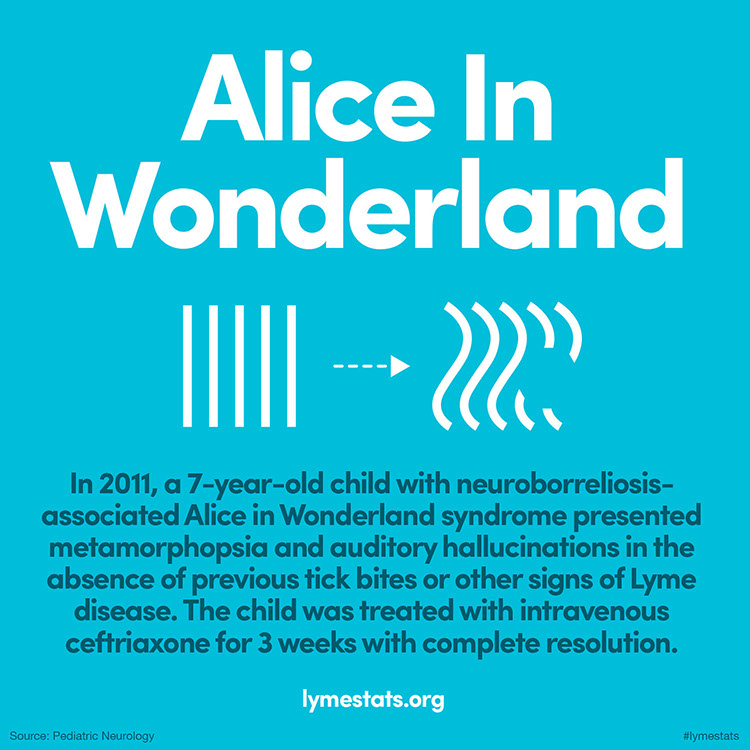
A 2011 study details a 7-year-old boy with Alice In Wonderland syndrome associated with Lyme disease. The boy presented metamorphopsia and auditory hallucinations in the absence of previous tick bites or other signs of Lyme disease. The boy never developed clinical seizures, and electroencephalograms during these spells indicated no epileptic activity. There was no history of migraine. Cranial magnetic resonance imaging produced normal results. Lyme serology tested positive in both serum and cerebrospinal fluid. He was treated with intravenous ceftriaxone for 3 weeks, with complete resolution of signs.
Source: Pediatric Neurology
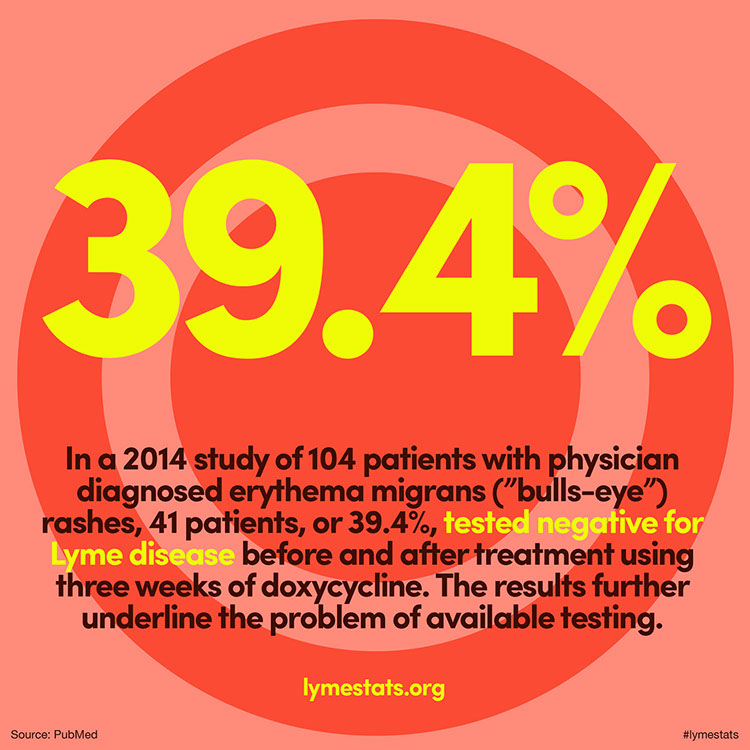
In a 2014 study of 104 patients with EM rashes, 39.4% of patients serologically tested negative for Lyme disease before and after three weeks of doxycycline, further implicating available serologic testing.
Source: PubMed
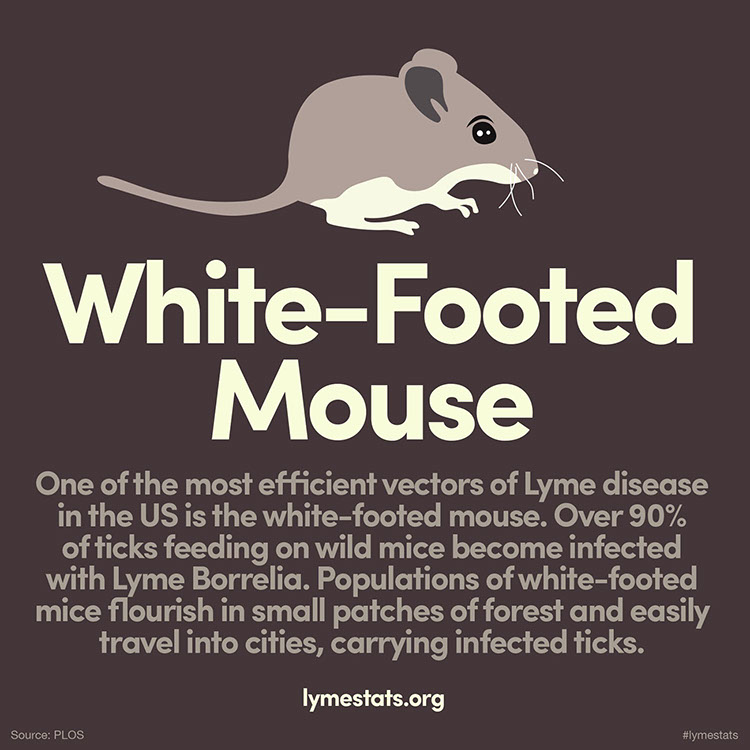
One of the most efficient vectors of Lyme disease is the white-footed mouse. Over 90% of ticks that feed on these mice become infected with Lyme Borrelia. White-footed mice thrive in small patches of forest and travel into cities, carrying infected ticks and infecting more along the way.
Source: PLOS

Cases of Lyme disease caused by the strain Borrelia miyamotoi are on the rise in America. Mother ticks can transmit this bacteria to their off-spring allowing larval ticks the possibility of transmitting the bacteria to humans. Larval ticks are the size of a pinhead, making early detection difficult. Common symptoms are fever, headache, fatigue, muscle aches, while EM rash, arthritis, or facial palsy are uncommon. According to the CDC, blood tests for Lyme disease are unlikely to be helpful in diagnosis of Borrelia miyamotoi infections.

The Delmarva Peninsula is endemic for Lyme disease. In 2014, the Delaware Lyme Disease Prevention Task Force was established to study and make recommendations to state and local leaders on how the First State should combat Borrelia burgdorferi and other tick-borne diseases such as: Bartonella, Anaplasma, Borellia miyamotoi, and Babesia.
Source: WMDT
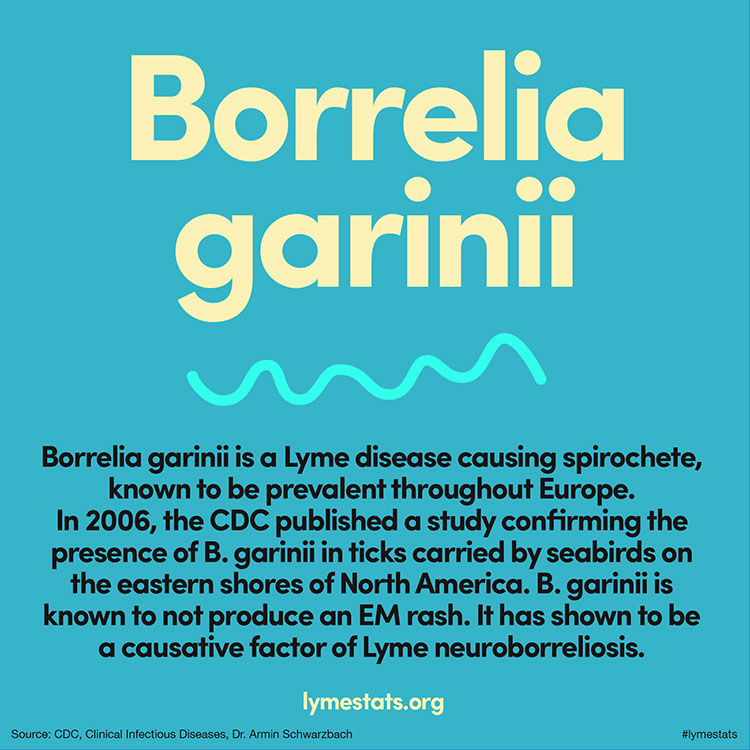
Borrelia garinii is a Lyme disease causing spirochete, known to be prevalent throughout Europe. In 2006, the CDC published a study confirming the presence of B. garinii in ticks carried by seabirds on the eastern shores of North America. B. garinii is known to not produce a “bulls-eye” rash. It has shown to be a causative factor of Lyme neuroborreliosis.
Source: CDC, Clinical Infectious Diseases, Dr. Armin Schwarzbach
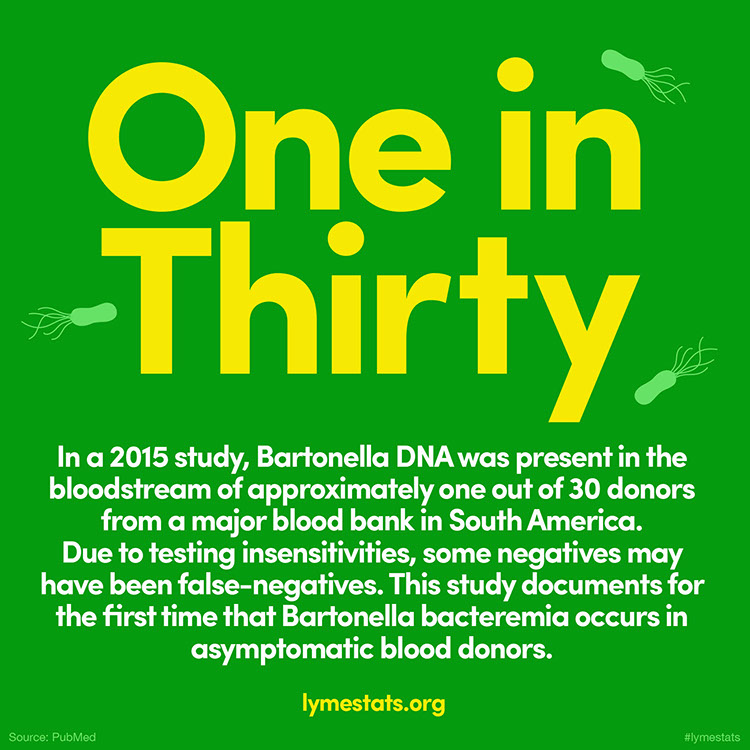
Bartonella species are blood-borne, re-emerging organisms, capable of causing prolonged infection with diverse disease manifestations, from asymptomatic bacteremia to chronic debilitating disease and death. This pathogen can survive for over a month in stored blood. However, its prevalence among blood donors is unknown, and screening of blood supplies for this pathogen is not routinely performed. In a 2015 study of 500 random blood donors, Bartonella DNA was present in the bloodstream of approximately one out of 30 donors from a major blood bank in South America.
Source: PubMed
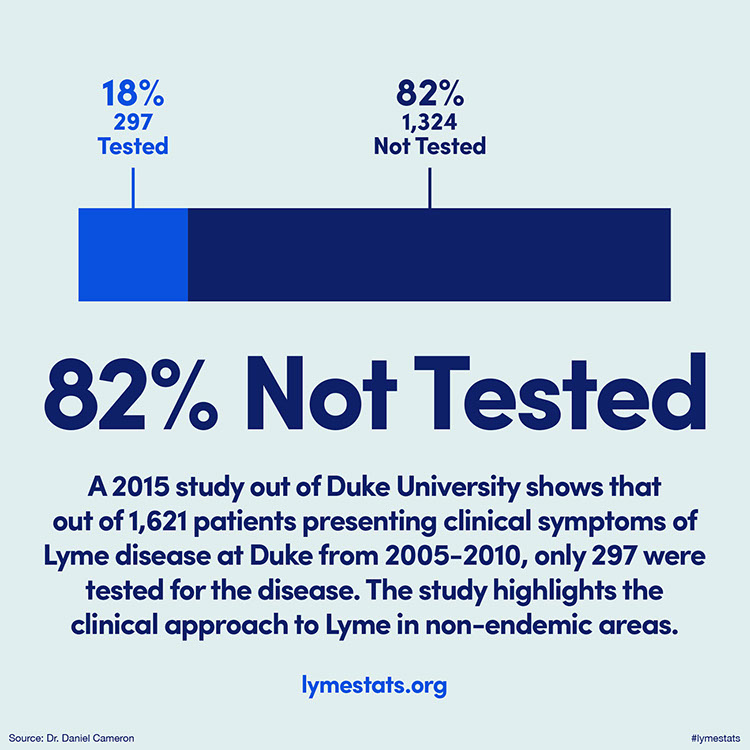
Most cases that are clinically consistent with Lyme disease are not tested in a non-endemic area as shown by a 2015 study from Duke University.
Source: Dr. Daniel Cameron
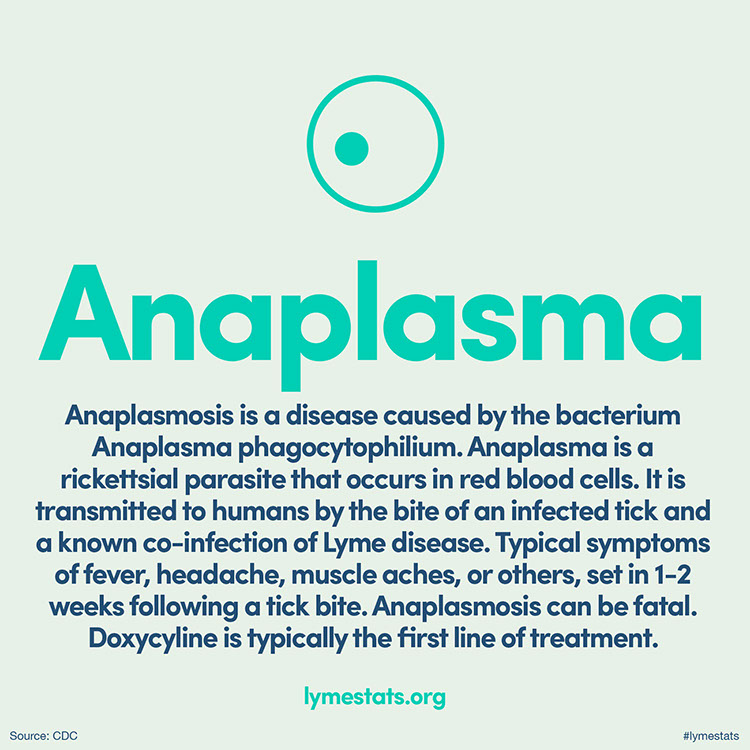
Anaplasma is a rickettsial parasite that occurs in the red blood cells. It is a known co-infection to Lyme disease, transmitted by an infected tick. Symptoms vary from patient to patient and set in 1-2 weeks following a bite. Anaplasmosis can be fatal even in previously healthy people. Doxycycline is typically the first line of treatment.
Source: CDC
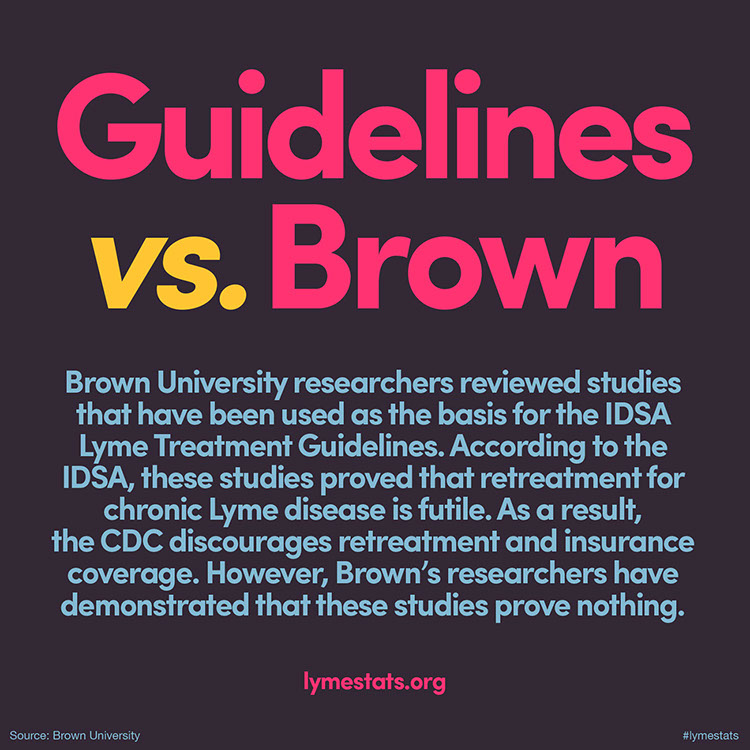
Allison DeLong of Brown University and other researchers analyzed the studies that are used as a basis for the IDSA Lyme Treatment Guidelines. DeLong states, “The interpretation of the trials goes too far,” she said. “You can’t say it’s been shown that retreatment is not beneficial. You can’t then jump to the conclusion that this shows there is no persistence of infection.” Ultimately, DeLong said, the best evidence to support or refute antibiotic retreatment will come when scientists develop a definitive test for active Lyme disease infection. In the interim, it is possible that chronic Lyme disease patients harbor an ongoing infection that antibiotics could treat.
Source: Brown University

It has been 40 years since the discovery of Lyme disease by Dr. Allen Steere, following a mysterious outbreak of juvenile rheumatoid arthritis near the community of Lyme, Connecticut.
Source: PubMed

Dr. Robert Lane, leading tick and Lyme disease entomologist, professor at UC Berkeley, advises to avoid sitting or leaning against wood, sitting on logs, or gathering wood. These are the most direct ways of contracting Lyme disease through infected ticks. Bathing two hours after exposure to dense, damp woods can aid in prevention of Lyme disease and co-infections.
Source: UC Berkeley

Mycoplasma is a known co-infection of Lyme disease. It is the smallest bacteria yet discovered and can survive without oxygen. Mycoplasma lack a cell wall which makes them difficult to remove with common antibiotics.
Source: Wikipedia

In 1998, a pioneering study led by Dr. Robert Lane found that a protein in the Western fence lizard’s blood killed Borrelia bacteria, and as a result, Lyme-infected ticks that feed on the lizard’s blood are cleansed of the disease-causing pathogen.
Source: UC Berkeley

In 2015, the Minnesota Department of Public Health conducted a retrospective surveillance study to gain insight on underreporting and underestimation of tick-borne disease (TBD), including Lyme, Anaplasmosis, and Babesiosis. The study found that the estimated number of “actual” reportable confirmed TBD diagnoses was found to be nearly 3 times as many as the number reported.
Source: ICEID
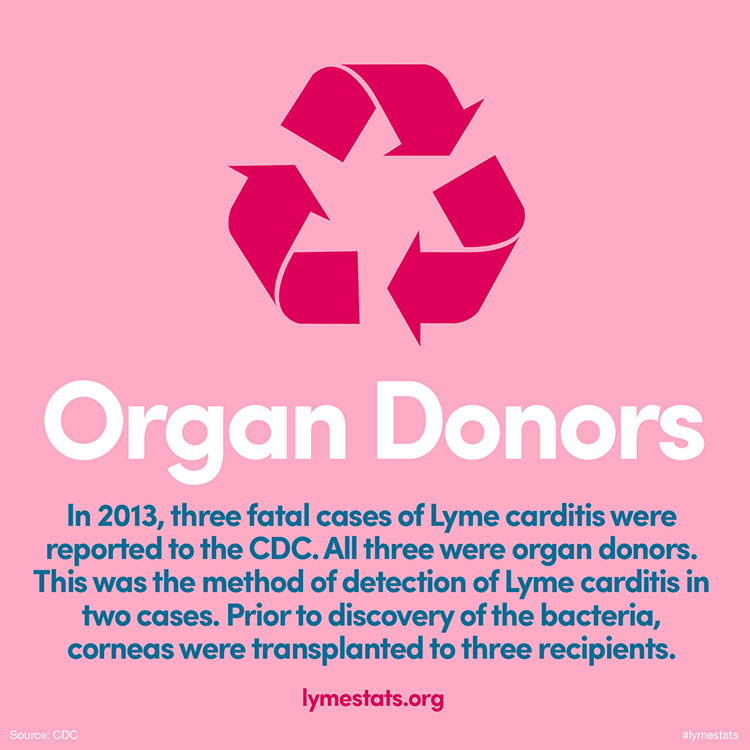
In 2013, three fatal cases of Lyme carditis (heart block) were reported to the CDC. All three were organ donors. This was the method of detection of Lyme carditis in two cases. Prior to discovery of the bacteria, corneas were transplanted to three recipients.
Source: CDC
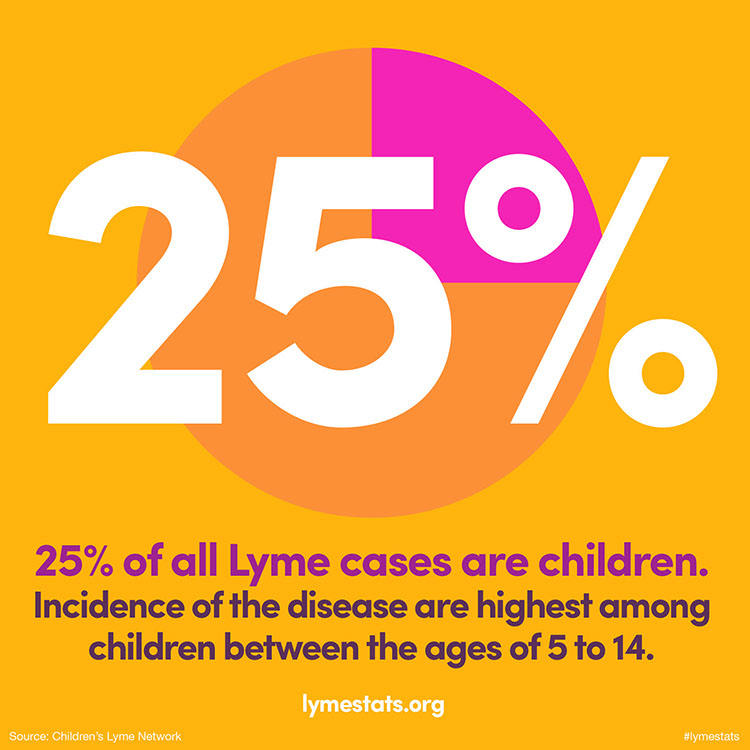
25% of all Lyme cases are children. Incidence of the disease are highest among children between the ages of 5 to 14.
Source: Children's Lyme Network

Studies show that Lyme disease may linger for 1 in 5 cases due to Borrelia "persisters".
Source: Scientific American

As of this publication, there are at minimum 23,432 crowd-fundraisers online for chronic Lyme patients. In these cases, fundraising is the only chance patients have to afford long lasting and complex treatment, as it is not covered by insurance. This is due to current IDSA/CDC Lyme Guidelines which claim that chronic Lyme does not exist.

In his latest studies, Dr. Alan MacDonald found two strains of Lyme Borrelia (miyamotoi and burgdorferi) in each of 5 brain samples from the Harvard Brain Bank. Borrelia DNA was found in all of the Alzheimer’s plaques, perfect spirochetes found in solid brain tissue, and granular bodies in dying nerve cells. His conclusion is that Borrelia causes Alzheimer's.
Source: Dr. Alan MacDonald

Phillip Baker, PhD, executive director of the American Lyme Disease Foundation (ALDF), has called chronic Lyme patients "Lyme loonies" and has worked to defeat federal legislation that would have provided more money for Lyme research and would have established a Lyme task force.
Source: Poughkeepsie Journal, lymedisease.org
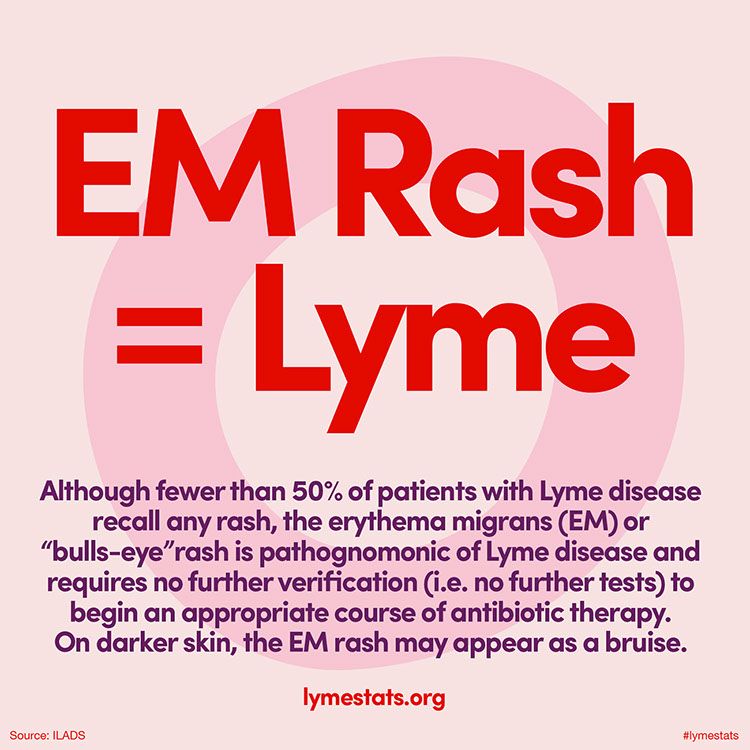
Although fewer than 50% of Lyme patients see a rash, the erythema migrans (EM) or “bull’s-eye” rash is pathognomonic of Lyme disease and requires no further verification prior to starting an appropriate course of antibiotic therapy.
Source: ILADS
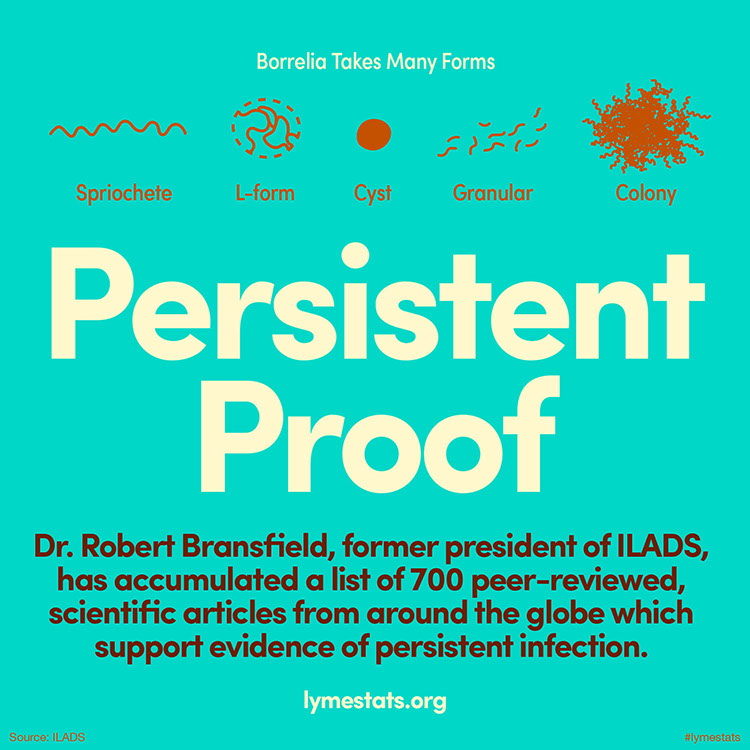
Dr. Robert Bransfield, past president of ILADS, has accumulated a list of 700 articles citing chronic infection associated with tick-borne diseases. The list contains over 700 articles and is divided into several different sections. The first section is a general list of articles supporting the evidence for persistent infection. The other sections support persistence as it pertains to psychiatric symptoms, dementia, autism, and congenital transmission.
Source: ILADS

In 40 years since Lyme disease was first recognized, the CDC is no closer to a cure, let alone proper management of this epidemic. On the contrary, the agency is promoting outdated treatment guidelines from a private group which maintains conflicts of interest.
Source: CDC

According to the Maine Medical Center Research Institute, more than half of all deer ticks in Maine are carrying Lyme and other pathogens. 9 out of 10 ticks in Southern Maine are deer ticks. They are especially prevalent throughout the fall months.

In a 2014 study of 20 patients with both dementia and neuroborreliosis (a Borrelia infection in brain tissue), 7 patients improved with antibiotic treatment, while the remaining patients experienced a worsening of dementia despite antibiotic treatment. These patients resulted with a diagnosis of Alzheimer's, Lewy Body Disease, a combination of, or other neurodegenerative diseases. The study's conclusion is that patients with dementia should be serologically tested for neuroborreliosis.
Source: PubMed

In a 2015 study by Dr. Eva Sapi and her research team at University of New Haven, Stevia whole leaf extract, as an individual agent, was found to be effective (in vitro) against all known morphological forms of Borrelia burgdorferi, including spirochetes, persisters, and biofilms. Stevia whole leaf extract outperformed often prescribed antibiotics including doxycycline.
Source: Dr. Eva Sapi, Uni. of New Haven

University of Connecticut researchers studying an invasive species, Japanese Barberry, have found that the plant creates the perfect, humid environment for ticks. Lyme infected tick populations flourish in the company of this plant and are greatly reduced when it is eliminated. ”When we measure the presence of ticks carrying the Lyme spirochete (Borrelia burgdorferi) we find 120 infected ticks [per acre] where Barberry is not contained, 40 ticks per acre where Barberry is contained, and only 10 infected ticks where there is no Barberry.” Eliminating Japanese Barberry and replacing it with native species can help stop the spread of Lyme, Babesia, and other tick-borne diseases.
Source: University of Connecticut

Dr. Beth Bell, Director of the National Center for Emerging and Zoonotic Infectious Diseases at the CDC, has stated that the CDC will continue preferential treatment of outmoded IDSA Lyme guidelines, which deny the existence of chronic Lyme, despite citizen requests to utilize the up-to-date IOM, GRADE compliant, and NGC-approved ILADS guidelines. Dr. Bell is also a member of the IDSA.
Source: The Mayday Project

The Bay Area Lyme Foundation received a $6.5 million grant from the Steven and Alexandra Cohen Foundation. This amount is the largest private donation ever given to Lyme disease research, and equals 1/4 the amount of funding currently allotted to Lyme by the NIH. However, this grant will work towards chronic Lyme, whereas the NIH studies the disease in its acute form. 100% of the gift will support Bay Area Lyme’s efforts towards improving diagnostic and treatment methods of Lyme disease through research and innovation.
Source: Bay Area Lyme Foundation
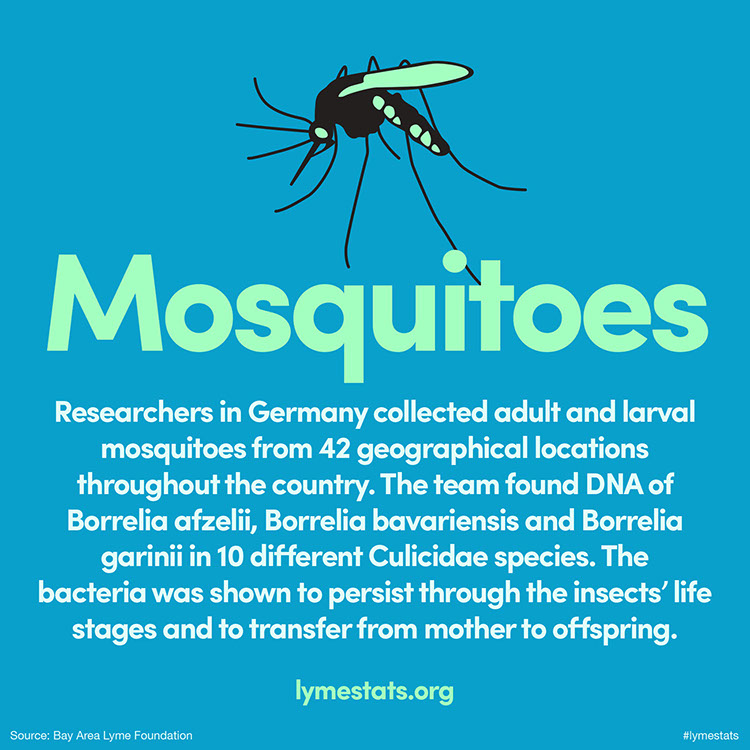
In the first such study of mosquitoes in Germany, researchers collected adult and larval mosquitoes from 42 geographical locations throughout the country. The team found Borrelia afzelii, Borrelia bavariensis and Borrelia garinii DNA in 10 different species. The bacteria was shown to persist through the insects’ life stages and shown to transfer from mother to offspring.
Source: Science Direct

A study of Lyme disease patients in the Southeastern United States (North Carolina, Georgia, and Florida) resulted in the recovery of live Borrelia burgdorferi sensu stricto and Borrelia bissettii-like strains. The patients had been CDC-negative and treated with doxycycline prior to the study. The findings highlight the need for further study of tick-borne pathogens in the region.

In a recent study, Borrelia miyamotoi, the agent of relapsing fever, was shown to survive standard storage conditions of most human blood components stored under standard blood bank conditions, suggesting the possibility of transmission by blood transfusion.
Source: Transfusion
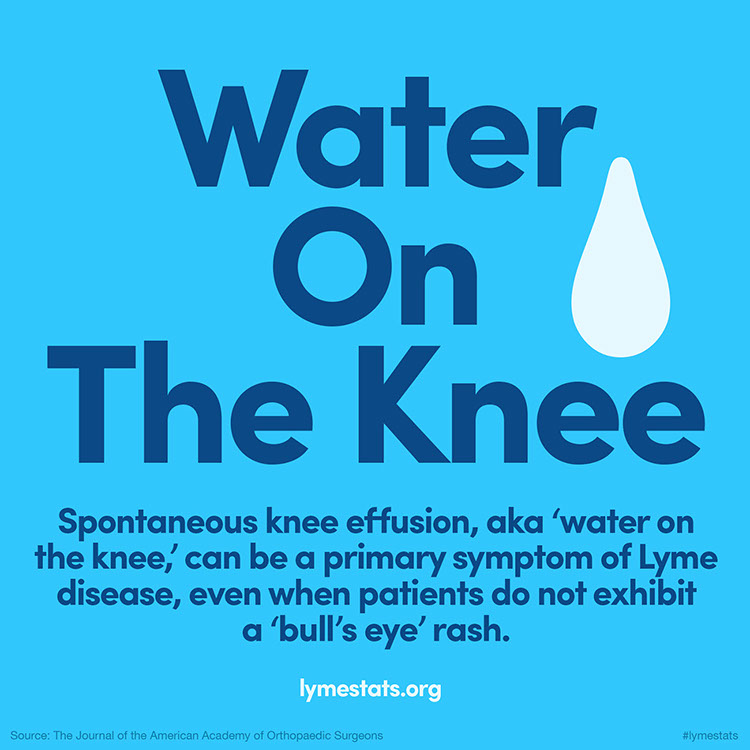
The Journal of the American Academy of Orthopaedic Surgeons reports that spontaneous knee effusion, aka ‘water on the knee,’ can be a primary symptom of Lyme disease, even when patients do not exhibit a ‘bull’s eye’ rash.
Source: Journal of the American Academy of Orthopaedic Surgeons
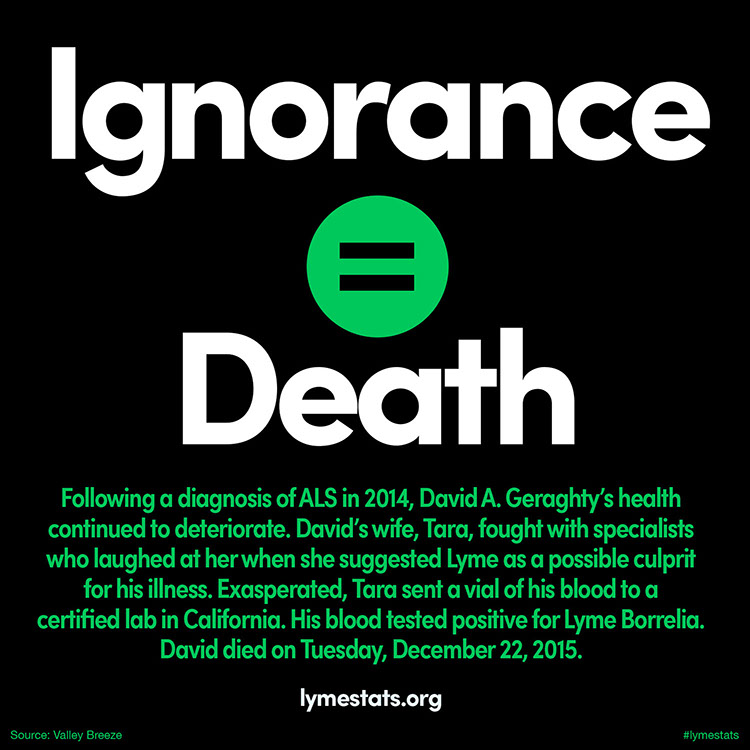
Lyme disease meets NIH’s eight characteristics of pandemics: The disease has a worldwide distribution; is moved long distances by birds; has a high attack rate and explosive spread; offers minimal immunity; can lead to a wide range of chronic manifestations not previously described; is transmitted by a vector; and can lead to severe illness or death. Lyme disease is a pandemic by definition.
Source: Dr. Daniel Cameron
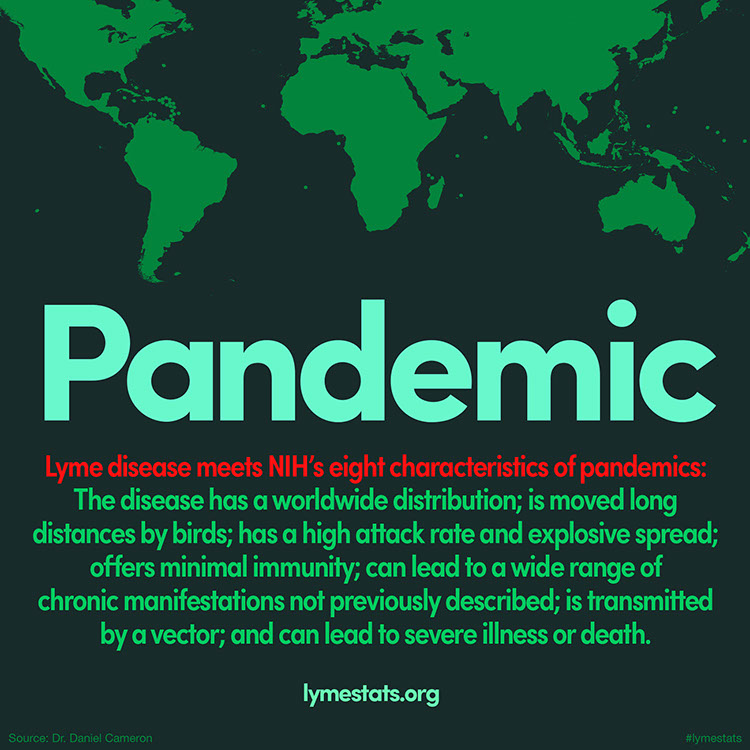
Following a diagnosis of ALS in 2014, David A. Geraghty’s health continued to deteriorate. David’s wife, Tara, fought with specialists who laughed at her when she suggested Lyme as a possible culprit for his illness. Exasperated, Tara sent a vial of his blood to a certified lab in California. His blood tested positive for Lyme Borrelia. David died of Lyme disease on Tuesday, December 22, 2015.
Source: Valley Breeze

From 2010-2014, Gary Wormser, MD, lead author of the IDSA Lyme Guidelines, received $1.5M in tax payer money to do research on subjective symptoms after treatment of Lyme disease. As of 2016, there are no published results. Dr. Wormser has attributed many chronic Lyme symptoms to “the aches and pains of daily living.”
Source: NIH

Dr. Alan MacDonald has discovered Borrelia DNA in 5 out of 5 Glioblastoma Multiformae (GBM) brain biopsies. The Borrelia spirochete is known to frequently invade the brain, bind to and penetrate brain cells, and cause tissue injuries. The discovery of huge amounts of DNA from the Borrelia bacteria lying inside of malignant brain tumor cells (GBM cells) implicates Borrelia infection of the brain as a cause of brain malignancy. This discovery is the very first of its kind in world literature.
Source: Dr. Alan MacDonald

Mayo Clinic researchers from Minnesota, North Dakota and Wisconsin, have discovered a new bacterial species that causes Lyme disease in people. The new species has been provisionally named Borrelia mayonii.
B. mayonii causes an illness that appears to be associated with nausea and vomiting, diffuse rashes (rather than a single bull’s-eye rash), and a higher concentration of bacteria in the blood.
Source: Mayo Clinic
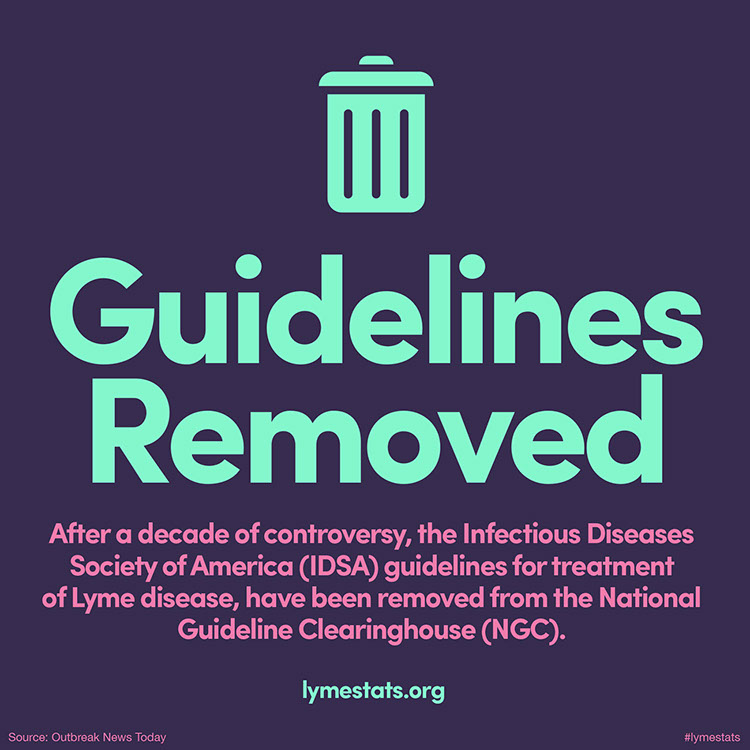
After a decade of controversy, the Infectious Diseases Society of America (IDSA) guidelines for treatment of Lyme disease, have lapsed and been removed from the National Guideline Clearinghouse (NGC). Lyme patients and advocates are calling on the CDC to follow suit by removing references to the IDSA guidelines from all CDC publications, and instead promote the IOM compliant 2014 Lyme guidelines from the International Lyme and Associated Diseases Society (ILADS). Allison Caruana, co-founder of the Mayday Project, says, “What’s more troubling, is that CDC officials who provide preferential treatment [to the IDSA] are also members of IDSA, — a glaring and long-standing conflict of interest.” Caruana points out that CDC’s preferential treatment of IDSA violates the Standards of Ethical Conduct for Employees of the Executive Branch, which states: “Employees shall act impartially and not give preferential treatment to any private organization or individual.”
Source: Outbreak News Today

Duke University’s top cancer researcher, Dr. Neil Spector, explains, “We don't talk about cancer as just one disease anymore, and we should stop talking about Lyme this way... Administering one algorithmic form of treatment doesn't work... And why wouldn't this bacteria figure out how to evade the immune system and antibiotic therapy? We already know this is true for syphilis; they're sister diseases… We are going to repudiate the dogmatic approach that has led to a lot of suffering.” The dogmatic approach Dr. Spector mentions is the CDC’s current notion (fed by an illegal and unethical preferential treatment of the IDSA Lyme Guidelines) that Lyme is only caused by one strain of Borrelia bacteria, it’s difficult to get, and easy to treat with a short course of antibiotics.
Source: Huffington Post

Bay Area Lyme Foundation is now offering free tick testing.
Source: Bay Area Lyme Foundation
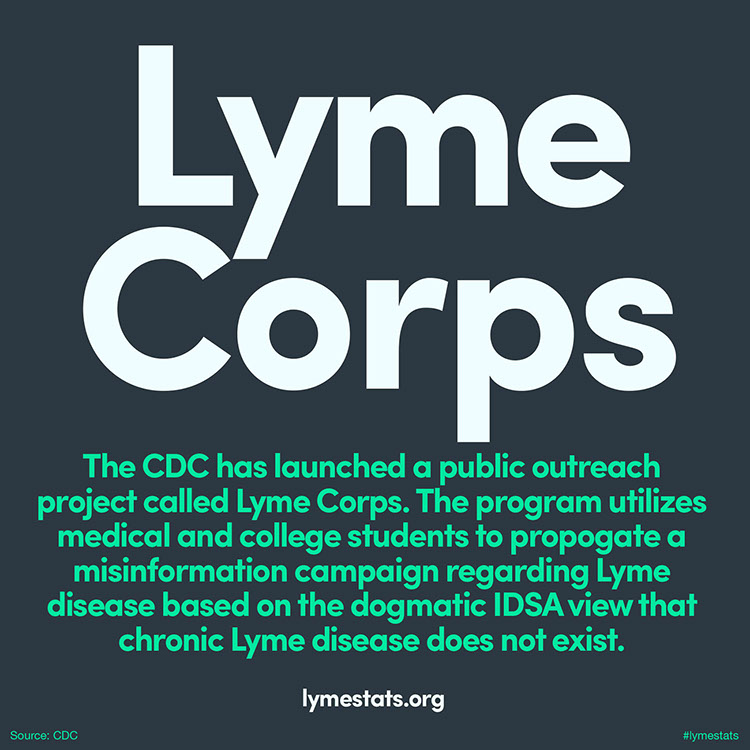
The CDC has launched a public outreach project called Lyme Corps. The program utilizes medical and college students to propogate a misinformation campaign regarding Lyme disease based on the dogmatic IDSA view that chronic Lyme disease does not exist.
Source: CDC

Following years of misdiagnosis, wheelchair-bound 12 year old, Julia Bruzzese, recently received a Lyme disease diagnosis and IV antibiotics. She has been showing improvement, however she will soon be unable to continue treatment. Her insurance company, Emblem Health, has denied coverage as they follow out-dated IDSA Lyme guidelines which claim that chronic Lyme does not exist. Julia’s experience is the norm with regard to chronic Lyme and insurance coverage. Nearly all patients must pay out of pocket for expensive, long-lasting treatment.
Source: The Bruzzese Family

The IDSA says they hope to complete the new Lyme treatment guidelines within 2-5 years. By that time, more than 1.5 million Americans will become new Lyme patients.
Source: IDSA

In a 1986 patent for the vaccine against Lyme disease, several examples of chronic Lyme disease are noted. The patent states, “chronic forms of the disease may last for months to years and are associated with the persistence of the spirochete”. The author cites studies by Allen Steere, an author of the IDSA Lyme guidelines. These guidelines claim that chronic Lyme does not exist and should not be treated. They are dogmatically supported by the CDC. The IDSA and CDC have known since the 80s that chronic Lyme exists.
Source: Patent US4721617
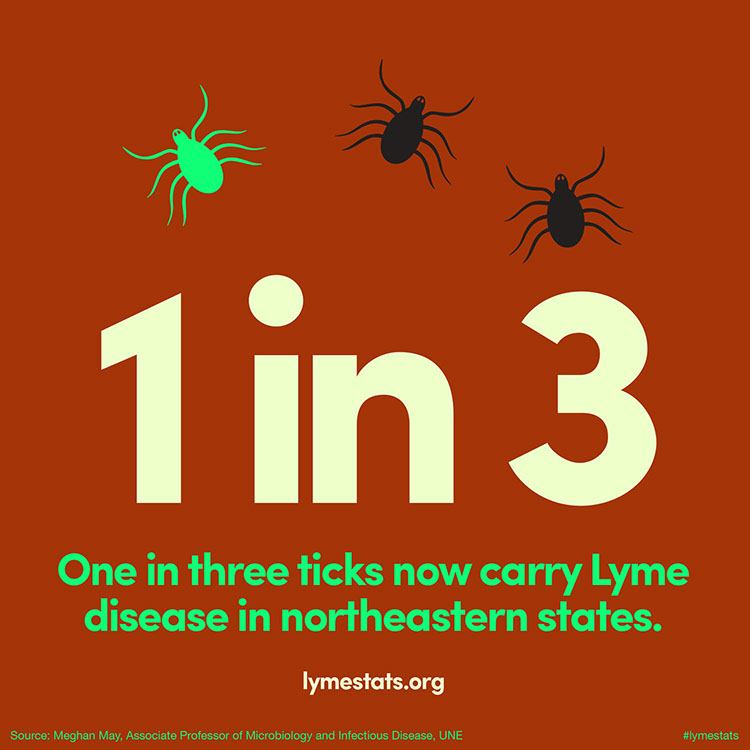
According to Meghan May, an infectious disease expert at the University of New England, the latest studies have found that 1 in 3 ticks in the northeast are infected with Lyme disease. That number is up from 1 in 4 in 2015.
Source: Meghan May, Associate Professor of Biomedical Sciences, UNE

Scientists have confirmed that the pathogen that causes Lyme disease -- unlike any other known organism -- can exist without iron, a metal that all other life needs to make proteins and enzymes. Instead of iron, the bacteria substitute manganese to make an essential enzyme, thus eluding immune system defenses that protect the body by starving pathogens of iron.

University of Bristol has conducted the largest ever study of ticks in dogs across the UK and found that almost 1/3 of all dogs were carrying a tick. Ticks carry a range of diseases including Lyme disease and potentially fatal canine babesiosis. The study also found that dogs were at risk of ticks regardless of whether they were urban or rural.
Source: University of Bristol

In 2015, the Alabama Department of Health released a statement alerting all state physicians that it is possible to contract Lyme disease inside the state, and in fact, seven counties are endemic for Lyme. The statement reads: “Today, Lyme disease should be considered in anyone with appropriate clinical symptoms, with or without known exposure to a tick bite or travel out of state.” Case counts have increased dramatically since 2011. In spite of this, the Alabama Lyme Disease Association is continuing to be flooded with calls from patients who are told by their physicians that despite positive blood tests, they "can't have Lyme because we don't have Lyme disease in Alabama".
Source: Alabama Department of Health

Congressional Candidate, Zephyr Teachout, is one of the first politicians to mention Lyme disease in a campaign video. In the video, she interviews renown physician, Dr. Richard Horowitz, who states that Lyme disease cases are likely 50 times the CDC incidence rate, bringing it to 1.5 million new cases per year.
Source: Zephyr Teachout

The first case of Babesiosis caused by the Babesia microti strain has been diagnosed in Spain. Babesiosis is an emerging zoonotic disease now found in several areas of the world.
Source: PubMed
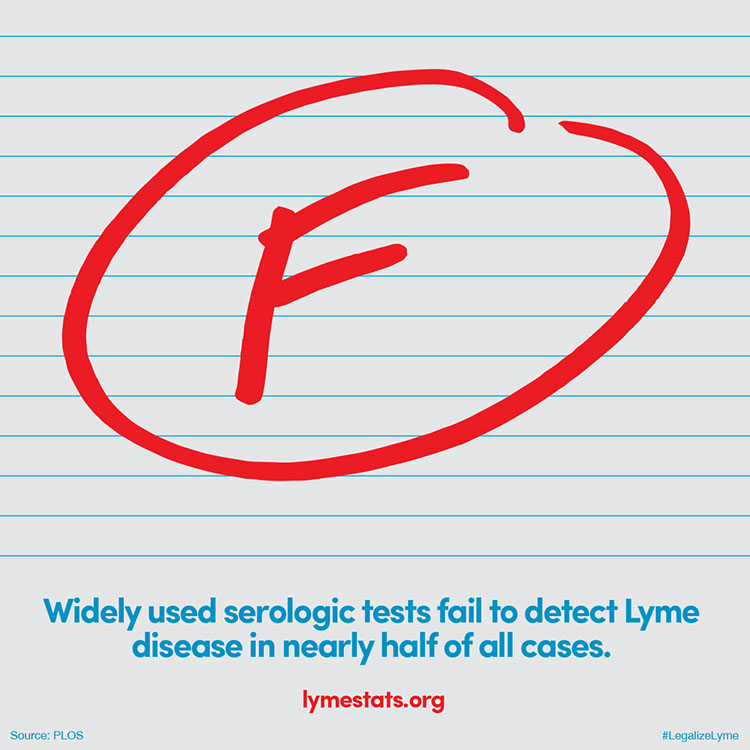
"Serologic tests have been used to detect early Lyme disease to allow for prompt treatment. However, nearly half of serologic tests failed to detect Lyme disease in a recent Systematic Review and Meta-Analysis of North American Research in the Journal, PLOS ONE. This study suggests that a clinical diagnosis remains necessary to allow for prompt treatment of nearly half of the early Lyme disease cases." -Dr. Daniel Cameron
Source: PLOS
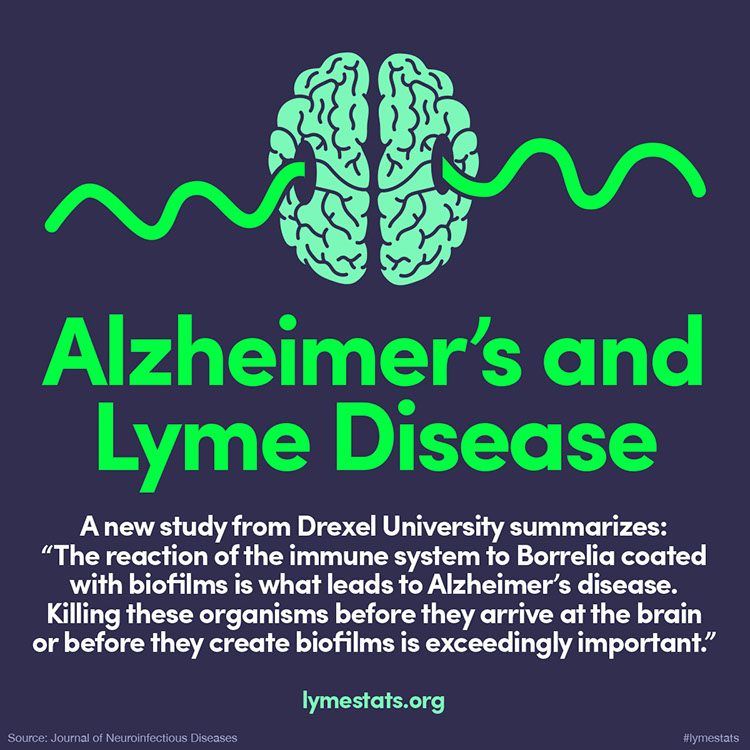
From a new study out of Drexel University which duplicates the findings of Dr. Alan MacDonald: “It is the reaction of the immune system to [Borrelia] coated with biofilms that leads to [Alzheimer’s] with all its manifestations. Killing these organisms before they arrive at the brain or before they [create biofilms] is exceedingly important in this disease. Moreover, it will likely lead to a “cure” of this woeful infirmity, just as has been the case in syphilitic dementia.”
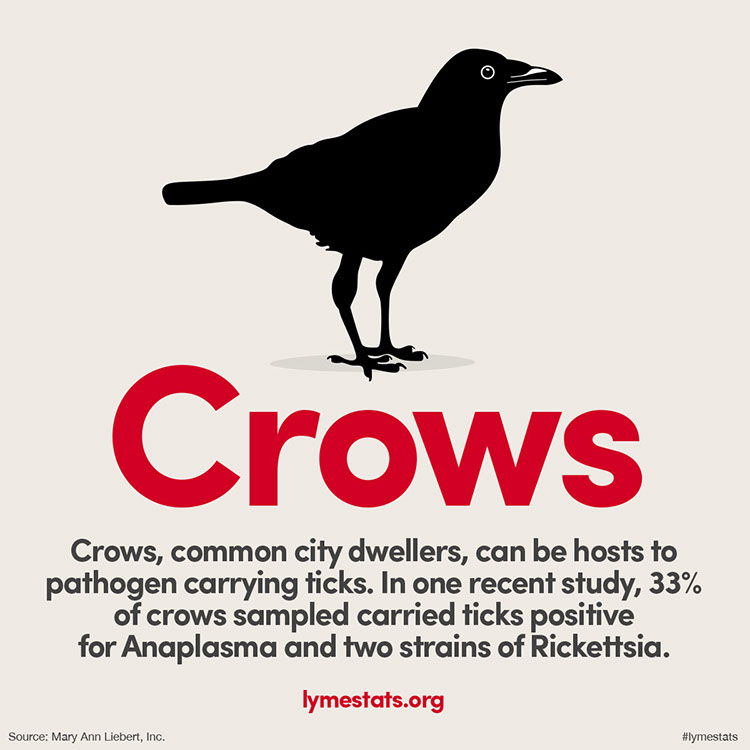
Crows, common city dwellers, can be hosts to ticks carrying zoonotic pathogens including Lyme, Anaplasma, and Rickettsia. In a recent study, 33% of crows sampled carried ticks positive for Anaplasma and two strains of Rickettsia.
Source: Mary Ann Leibert

A 2010 study claims that transmission of Bartonella to humans from ticks has not yet been documented. Their findings implicate cats and cat flea feces as possible transmitters. They saw Bartonella as a coincidental co-infection to Lyme disease. "Bites or scratches from infected cats are associated with development of cat-scratch disease. The gut of cat fleas is commonly infected, and exposure to feces of infected fleas is the presumed route of transmission to uninfected cats and a possible route of transmission to humans."
Source: Emerging Infectious Diseases

In an in-vitro evaluation of five antibiotics typically used against Lyme Borrelia, Doxycycline reduced spirochetal structures by 90% but increased the number of round bodies about twofold. Round bodies are also known as the (dormant) cyst form of Lyme. Once the host environment is free of killers, round bodies revert to spirochetes and resume penetration of the host body. A short course of Doxycycline is the CDC-recommended therapy for Lyme disease.
Source: Infection and Drug Resistance
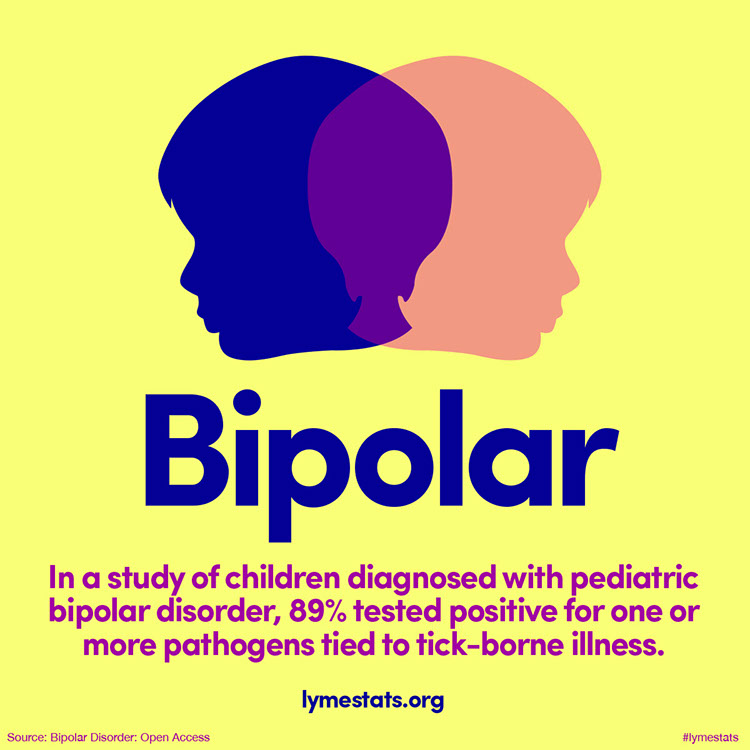
In a study of 27 children diagnosed with pediatric bipolar disorder (PBD), 89% tested positive for one or more pathogens tied to tick-borne illness. Pathogens included Lyme (Borrelia burgdorferi), Bartonella, Babesia, and Mycoplasma pneumoniae. 81% of the sample was male and 19% was female. Average age at PBD diagnosis was 7.3 years.
Source: Bipolar Disorder: Open Access
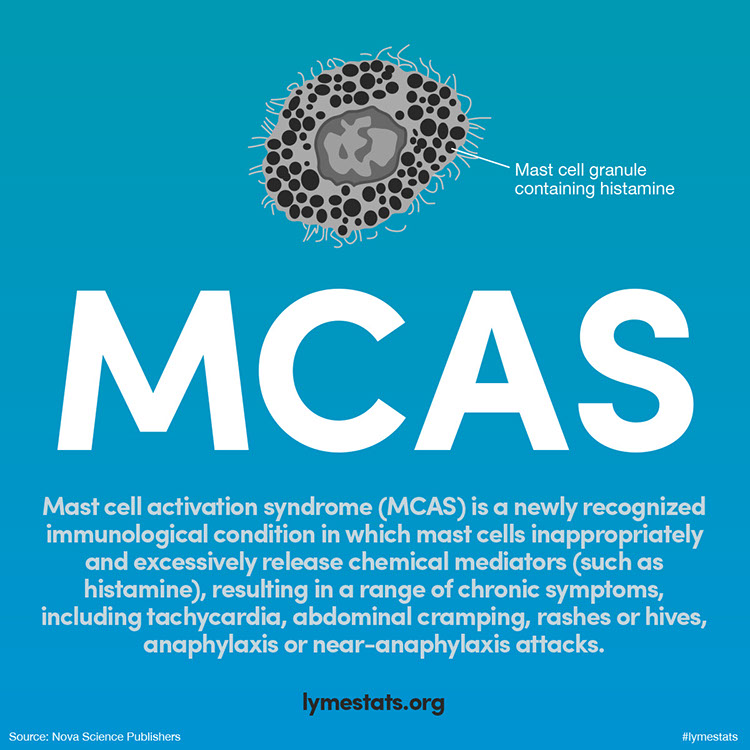
Mast cell activation syndrome (MCAS) is a newly recognized immunological condition in which mast cells inappropriately and excessively release chemical mediators, resulting in a range of chronic symptoms, sometimes including anaphylaxis or near-anaphylaxis attacks. Primary symptoms include cardiovascular, dermatological, gastrointestinal, neurological and respiratory problems. Lyme Literate Doctors (LLMDs) are discovering that a high percentage of their patients test positive for MCAS.
Source: Nova Science Publishers

Adding to decades of evidence that Lyme borrelia is capable of persistence, a new 2017 study from Tulane University found that the bacteria can survive antibiotic treatment following infection. The researchers used several important techniques, including xenodiagnoses, to determine if the bacteria persisted. The study measured antibody immune response to the bacteria both before and after treatment, which is how current diagnostics typically evaluate Lyme disease in humans. Living B. burgdorferi spirochetes were found in multiple organs after treatment with doxycycline. Immune response to the bacteria varied widely in both treated and untreated subjects.
“It is apparent from these data that B. burgdorferi bacteria, which have had time to adapt to their host, have the ability to escape immune recognition, tolerate the antibiotic doxycycline and invade vital organs such as the brain and heart,” said lead author Monica Embers, assistant professor of microbiology and immunology at Tulane University School of Medicine. “Although current antibiotic regimens may cure most patients who are treated early, if the infection is allowed to progress, the 28-day treatment can be insufficient, based on these findings.” The study also found: • All subjects treated with antibiotics were found to have some level of infection 7 – 12 months post treatment. • Despite testing negative by antibody tests for Lyme disease, two of 10 subjects were still infected with Lyme bacteria in heart and bladder. • Lyme bacteria which persist after antibiotic treatment are still viable.
Source: Tulane University

Lyme disease is in Spain. In a 2017 study of Ixodes ricinus ticks in the northwestern region of Spain, 32.3% of adult female ticks tested positive for Borrelia burgdorferi (sensu lato). Multiple genospecies were also found: B. garinii, B. valaisiana, B. lusitaniae, B. afzelii, B. burgdorferi (sensu stricto) and B. miyamotoi. From the study: "The significant prevalences of B. burgdorferi (s.l.) genospecies detected in questing ticks from NW Spain are similar to those detected in northern and central European countries and higher to those previously found in Spain. These results together with the high incidence of LB in humans and the high seroprevalence of B. burgdorferi (s.l.) in roe deer shown in other studies reveal that the northwest area is one of the most risky regions for acquiring LB in Spain."
Source: PubMed

Dementia can be a symptom of Lyme disease. In a 2017 report, an 80-year-old patient was first suspected of suffering from Alzheimer’s disease. However after a spinal tap was tested for Lyme Borrelia, the patient was found to be positive for Lyme disease (neuroborreliosis). Symptoms of dementia resolved after the administration of antibiotics. Lyme disease can easily be misdiagnosed as Alzheimer’s, Lewy Body Dementia, Parkinson’s, or any neurodegenerative disease presenting as dementia.
Source: PubMed

From the report: "To determine whether human Borrelia miyamotoi infection occurs in the far-western United States, we tested archived [blood samples] from northwestern California residents for antibodies to this emerging relapsing fever spirochete. These residents frequently were exposed to I. pacificus ticks in a region where B. miyamotoi tick infection has been reported." Out of 101 residents, 26 were positive. Their blood samples were drawn in 1988 or 1989. The study concludes: "Health care professionals in the far-western United States should be aware that B. miyamotoi disease may occur throughout the geographic distribution of I. pacificus and that improved relapsing fever group spirochete antibody assays are urgently needed."
Source: PLOS ONE

Follow Lyme Stats
©2015-2018 Lyme Stats
Lyme Stats is an information and statistic design project.




